It is the Nobel Prize week, and yet you, dear reader, came to this website where Nobelists are constantly being pooh-poohed upon. So you shall not be disappointed, for our hero here is the winner of the 2019 Nobel Prize for Physiology or Medicine, Gregg Semenza, professor at the Johns Hopkins University in USA.
Semenza shared his 2019 Nobel Prize with two other researchers, but only his papers keep popping up on PubPeer bearing telltale signs of data fakery. There are some recurrent author names suggesting naughty mentees or collaborators, but still, in many cases Semenza is the last and corresponding author, so the final responsibility is his. After all, also Nobel Prize recognition comes from that same last authorship.
First, some scientific background. The Nobel Prize Committee explains the 2019 award scientific rationale:
“Animals need oxygen for the conversion of food into useful energy. The importance of oxygen has been understood for centuries, but how cells adapt to changes in levels of oxygen has long been unknown. William Kaelin, Peter Ratcliffe, and Gregg Semenza discovered how cells can sense and adapt to changing oxygen availability. During the 1990s they identified a molecular machinery that regulates the activity of genes in response to varying levels of oxygen. The discoveries may lead to new treatments of anemia, cancer and many other diseases.”
Like everything else in cancer research, the hypoxia field is full of fraud, just search “HIF” (hypoxia-inducible factor which Semenza discovered) alone on PubPeer. One should hope the Nobel Prize (and Lasker, and other award-winning) labs might provide a pleasant exception, but alas…
In an interview with the Journal of Clinical Investigation (JCI) on the occasion of his Nobel Prize, Semenza was quoted:
“The one thing I pretended when I was younger was that I was an FBI agent. Investigating crimes, being a detective, it’s like being a scientist, right?“
Well, now science detective Clare Francis had a look into Semenza’s papers. And there was a lot, over 20 flagged papers on PubPeer before Clare Francis gave up and moved on to another case. The findings in Semenza’s research are rivalling those of another winner of the Nobel Prize in Physiology or Medicine, Louis Ignarro, so this is rather serious.
Have a look at this 8-year old paper on HIF-1 from the Semenza lab:
H Zhang, C C L Wong, H Wei, D M Gilkes, P Korangath, P Chaturvedi, L Schito, J Chen, B Krishnamachary, P T Winnard, V Raman, L Zhen, W A Mitzner, S Sukumar, G L Semenza HIF-1-dependent expression of angiopoietin-like 4 and L1CAM mediates vascular metastasis of hypoxic breast cancer cells to the lungs Oncogene (2012) doi: 10.1038/onc.2011.365
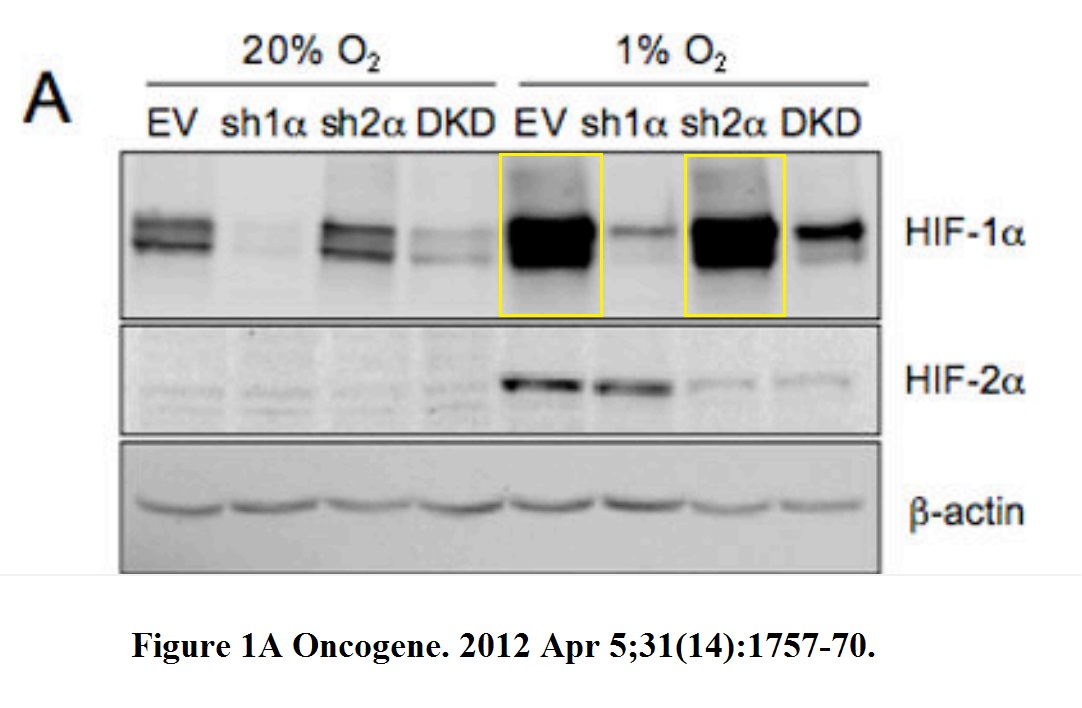
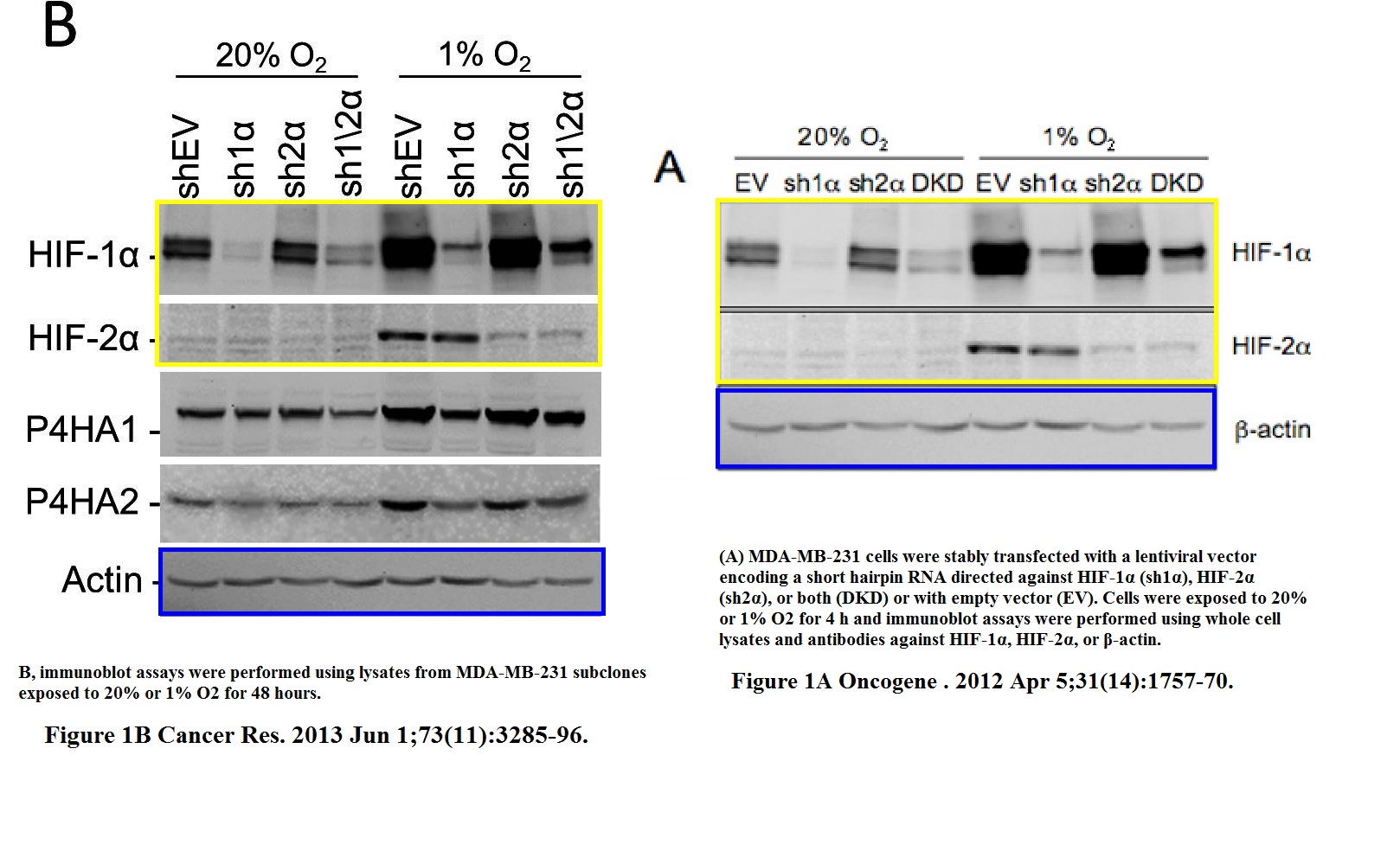
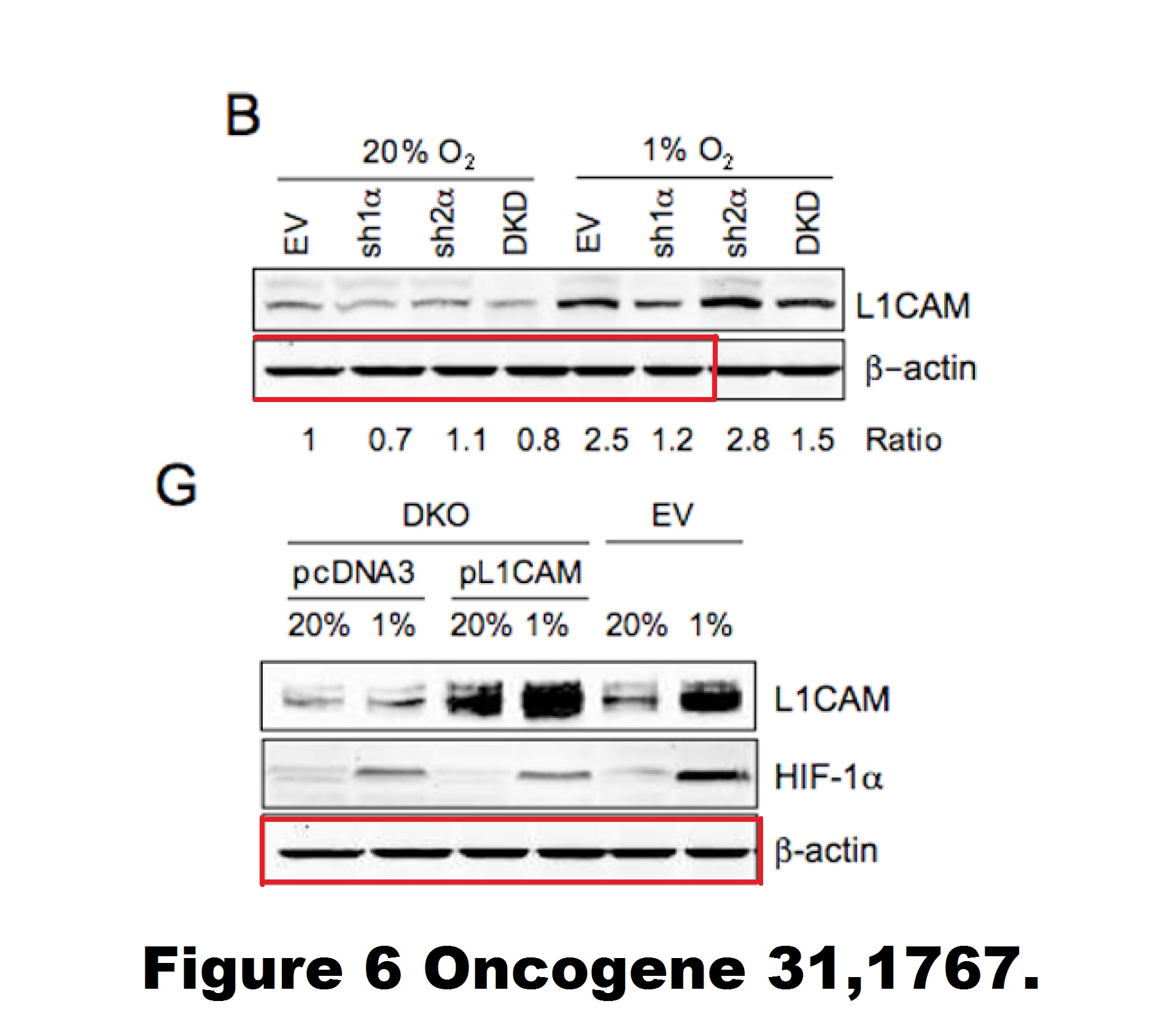
A gel in Figure 1A contains two bands which are likely copy-pasted. Figure 6 reuses a loading control for utterly unrelated experiments and samples. Judging from the band shapes and spacing, the beta-actin blot does not match either the gel shown in panel B nor G.
The issue with Figure 1A is minor compared to that: the research results were recycled in a different paper, Gilkes et al Cancer Research 2013. Luckily for all involved, Oncogene‘s Editor-in-Chief Justin Stebbing practices research integrity only in theory.
Or how about this 7 year old paper, again with Semenza as last author, where the Nobel-Prize-winning HIF1a data suffered some copy-pasting.
Daniele M. Gilkes, Saumendra Bajpai, Carmen C. Wong, Pallavi Chaturvedi, Maimon E. Hubbi, Denis Wirtz, Gregg L. Semenza Procollagen lysyl hydroxylase 2 is essential for hypoxia-induced breast cancer metastasis Molecular cancer research : MCR (2013) doi: 10.1158/1541-7786.mcr-12-0629
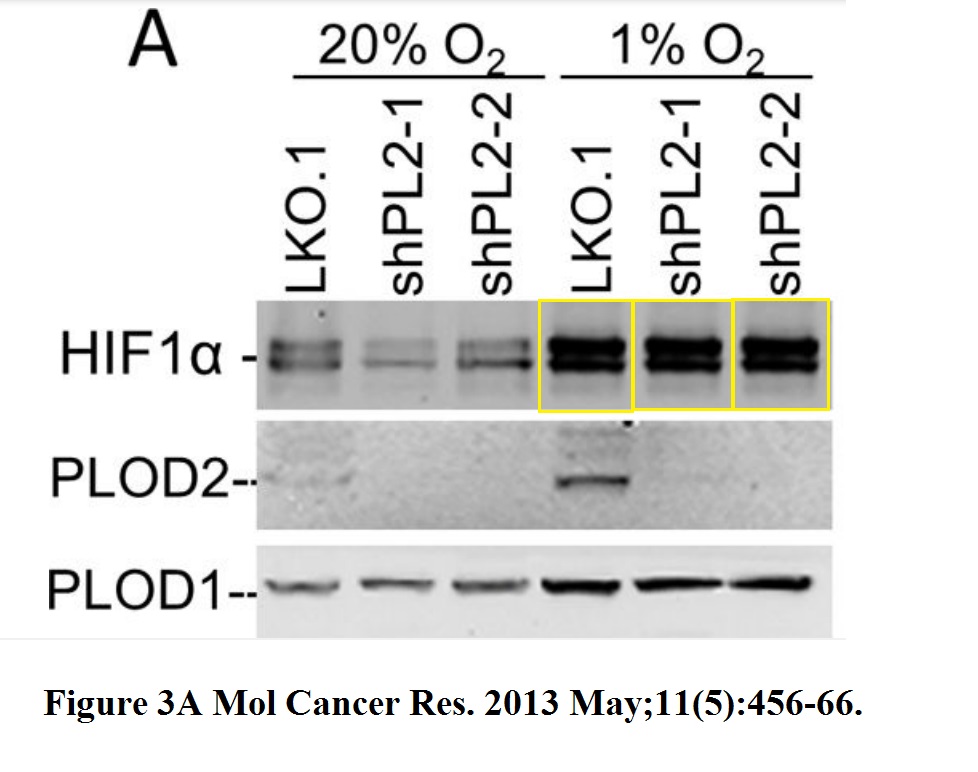
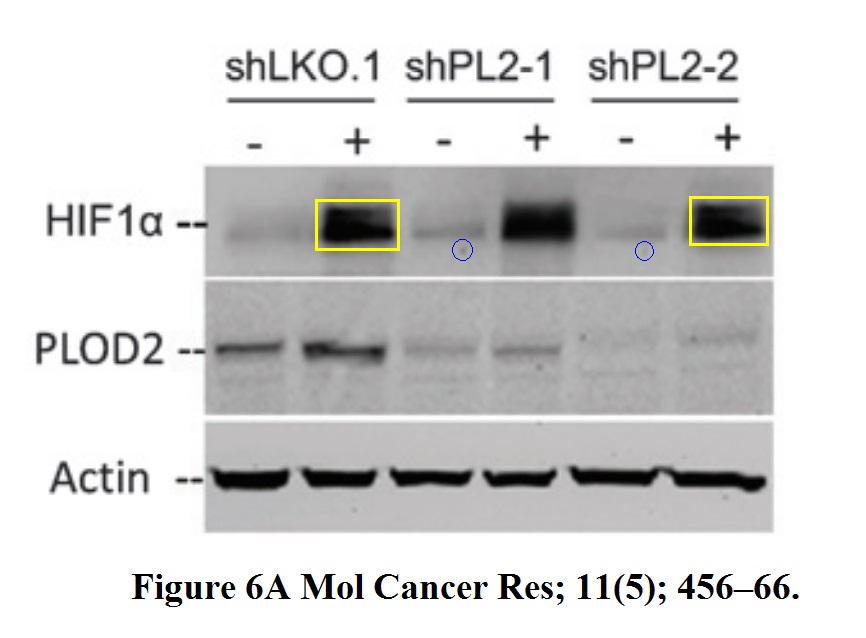
The first author of the above paper, Daniele Gilkes, remained close to her mentor and is now assistant professor at Johns Hopkins. In case you might think Semenza had no clue what his postdoc was doing, here their own words:
“Having a mentor that was both a clinician and a scientist was extremely important and impactful for my training,” Gilkes said. “Gregg helped me to focus on research that could make a true impact on improving outcomes.” […]
She noted that even with as many as 15 people in the lab, Semenza always responded quickly to her questions.
“I try to do that for my students, because that was really important to me,” she said. “It made me feel like he was very interested in the work that I was doing and that it was important to him. But it’s difficult to emulate.”
Is Gilke teaching her student the Art of the Photoshop now? Maybe. Here another first-author paper of hers from Semenza lab, where Johns Hopkins University’s Vice Provost for Research, Denis Wirtz, is again coauthor. In this capacity, Wirtz would be in charge of investigating the Nobelist’s papers (including those he himself coauthored) for suspected research misconduct.
Daniele M. Gilkes, Saumendra Bajpai, Pallavi Chaturvedi, Denis Wirtz, Gregg L. Semenza Hypoxia-inducible factor 1 (HIF-1) promotes extracellular matrix remodeling under hypoxic conditions by inducing P4HA1, P4HA2, and PLOD2 expression in fibroblasts The Journal of biological chemistry (2013) doi: 10.1074/jbc.m112.442939

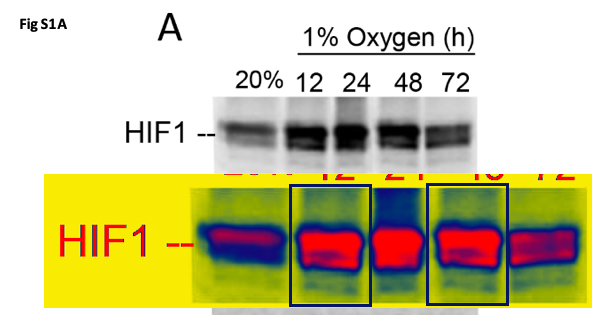
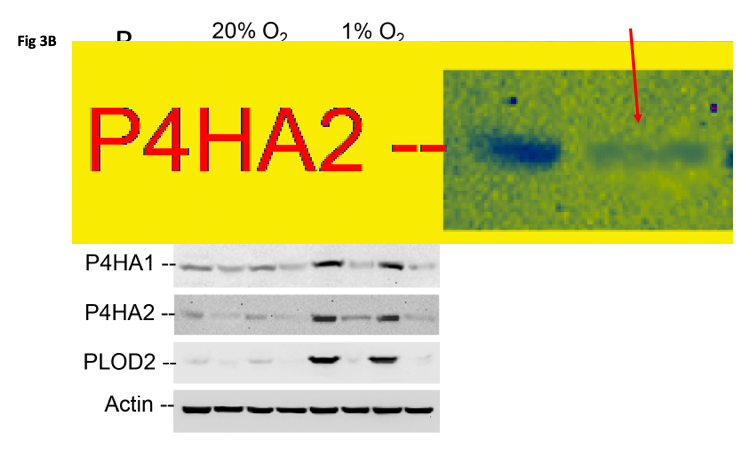
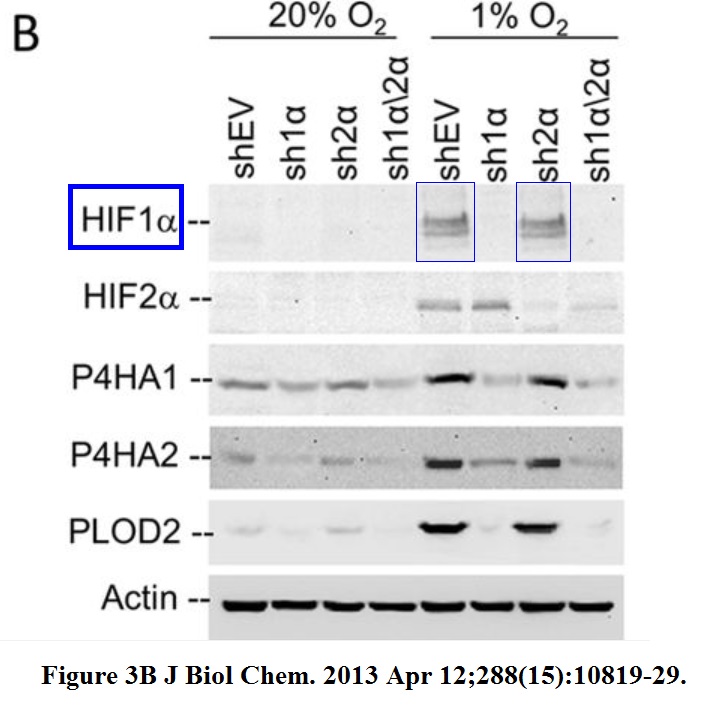
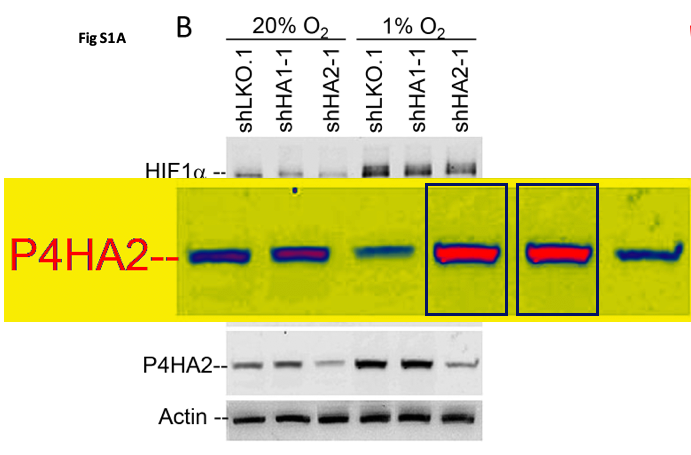
An utter disaster. Someone should be worried now, because the journal JBC and its society publisher ASBMB are quite tough on data fakery.
The next Gilkes et al paper from Semenza’s lab, again with Wirtz as coauthor, is also an utter train wreck, and is only safe from any danger of retraction because PNAS never cares about such things, certainly not with contributed (i.e., not really peer reviewed) papers. And this one was eminently contributed by the National Academy of Sciences member Semenza himself.
Daniele M Gilkes, Lisha Xiang, Sun Joo Lee, Pallavi Chaturvedi, Maimon E Hubbi, Denis Wirtz, Gregg L Semenza Hypoxia-inducible factors mediate coordinated RhoA-ROCK1 expression and signaling in breast cancer cells Proceedings of the National Academy of Sciences of the United States of America (2014) doi: 10.1073/pnas.1321510111

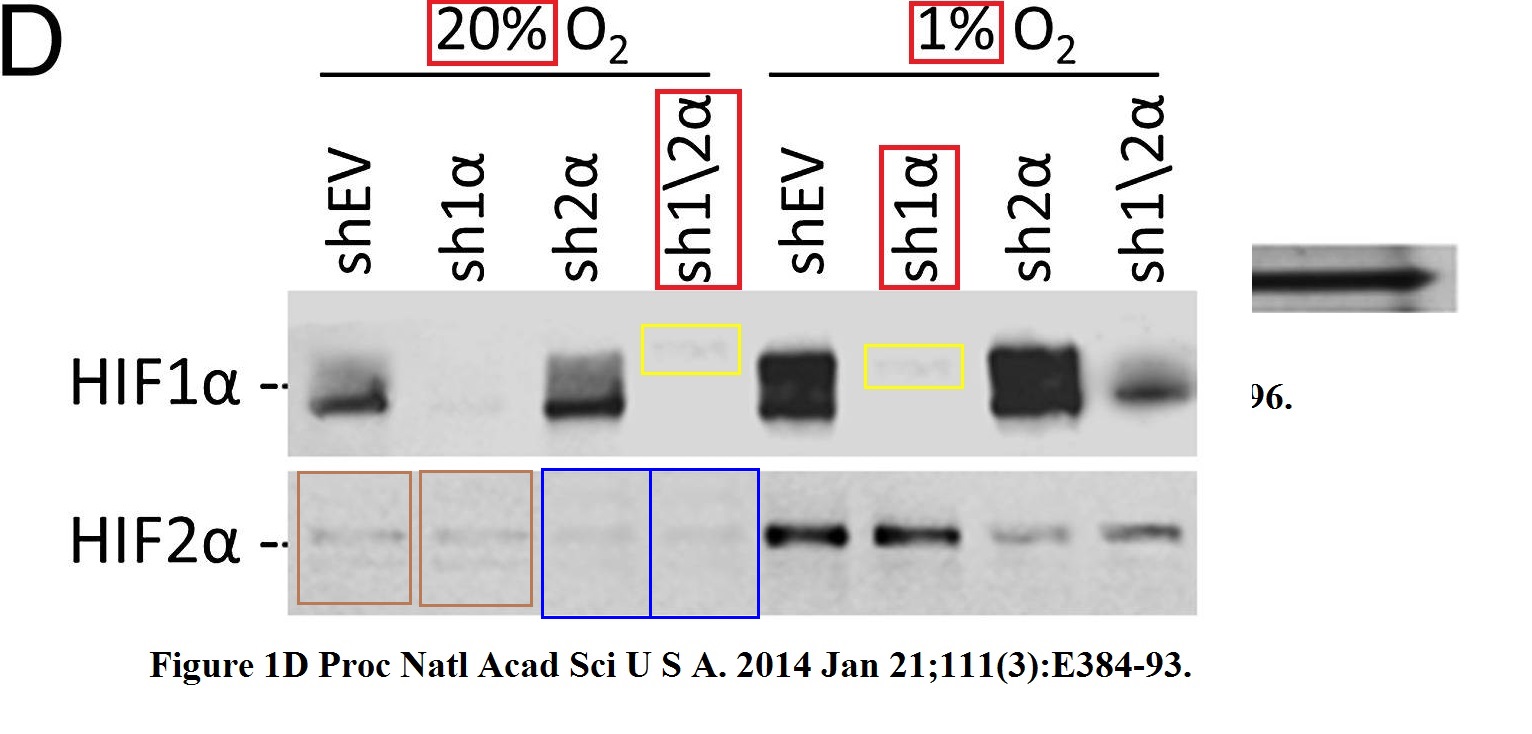
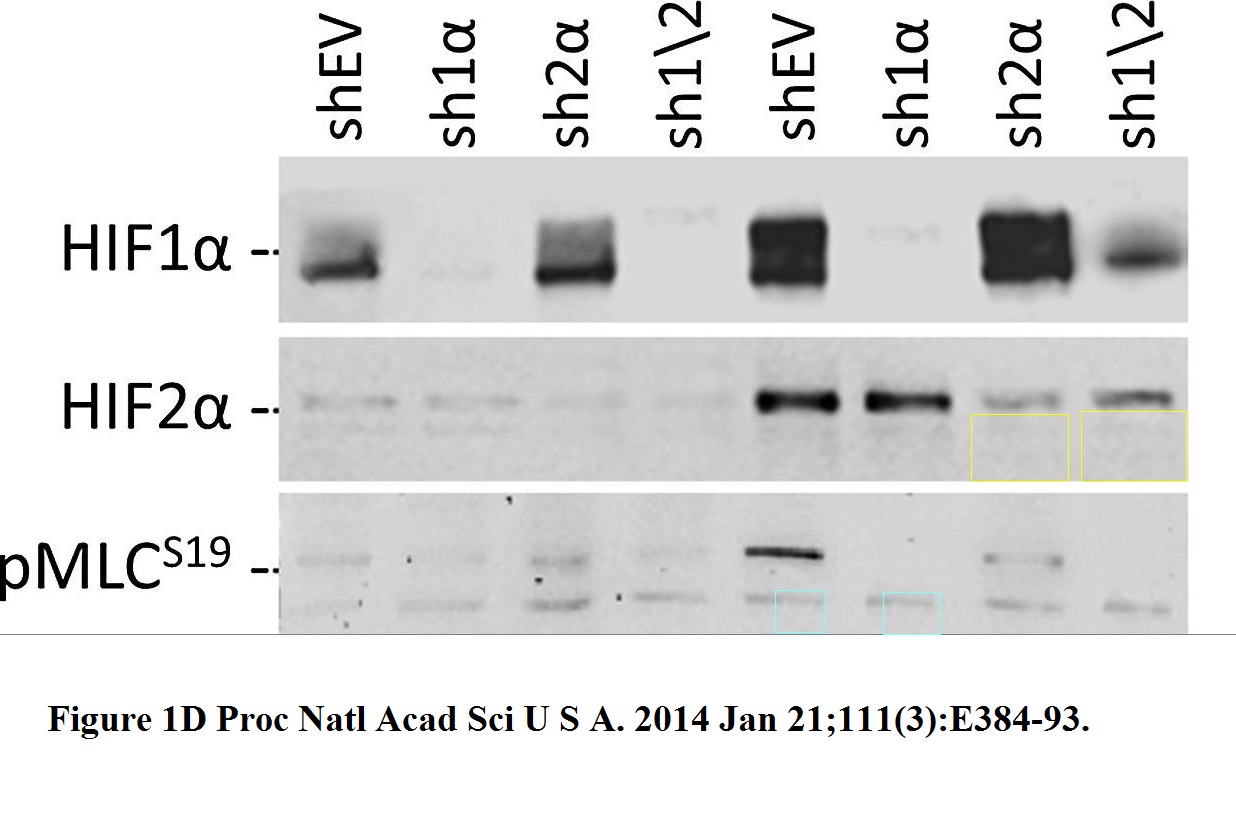

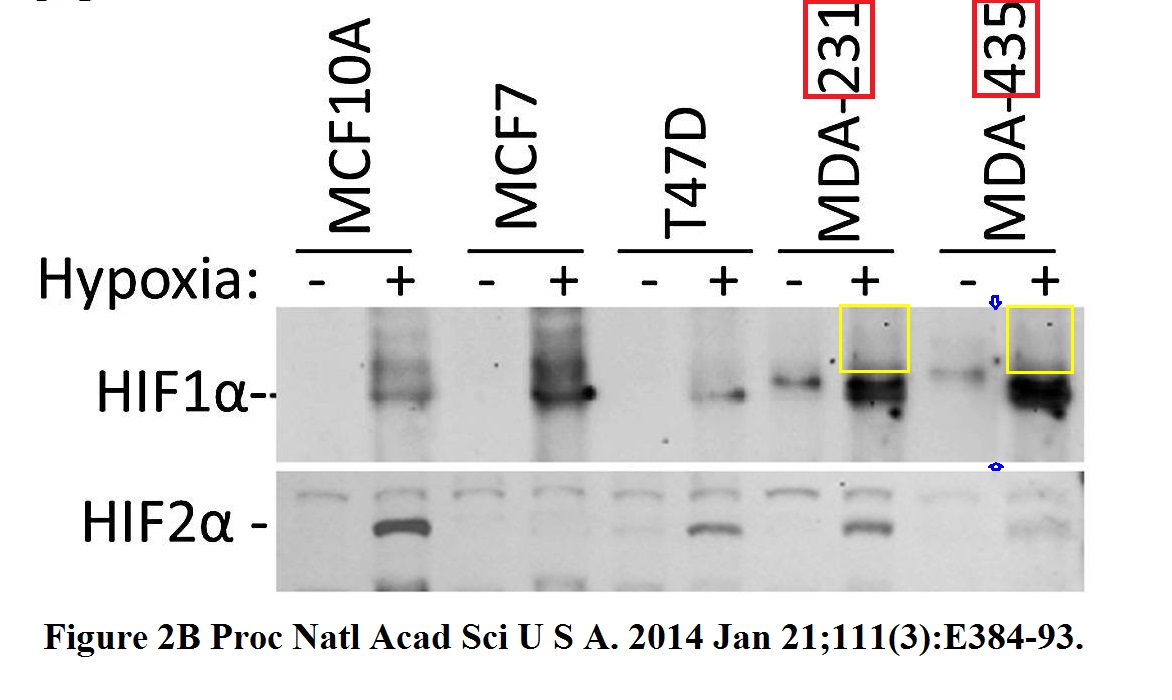
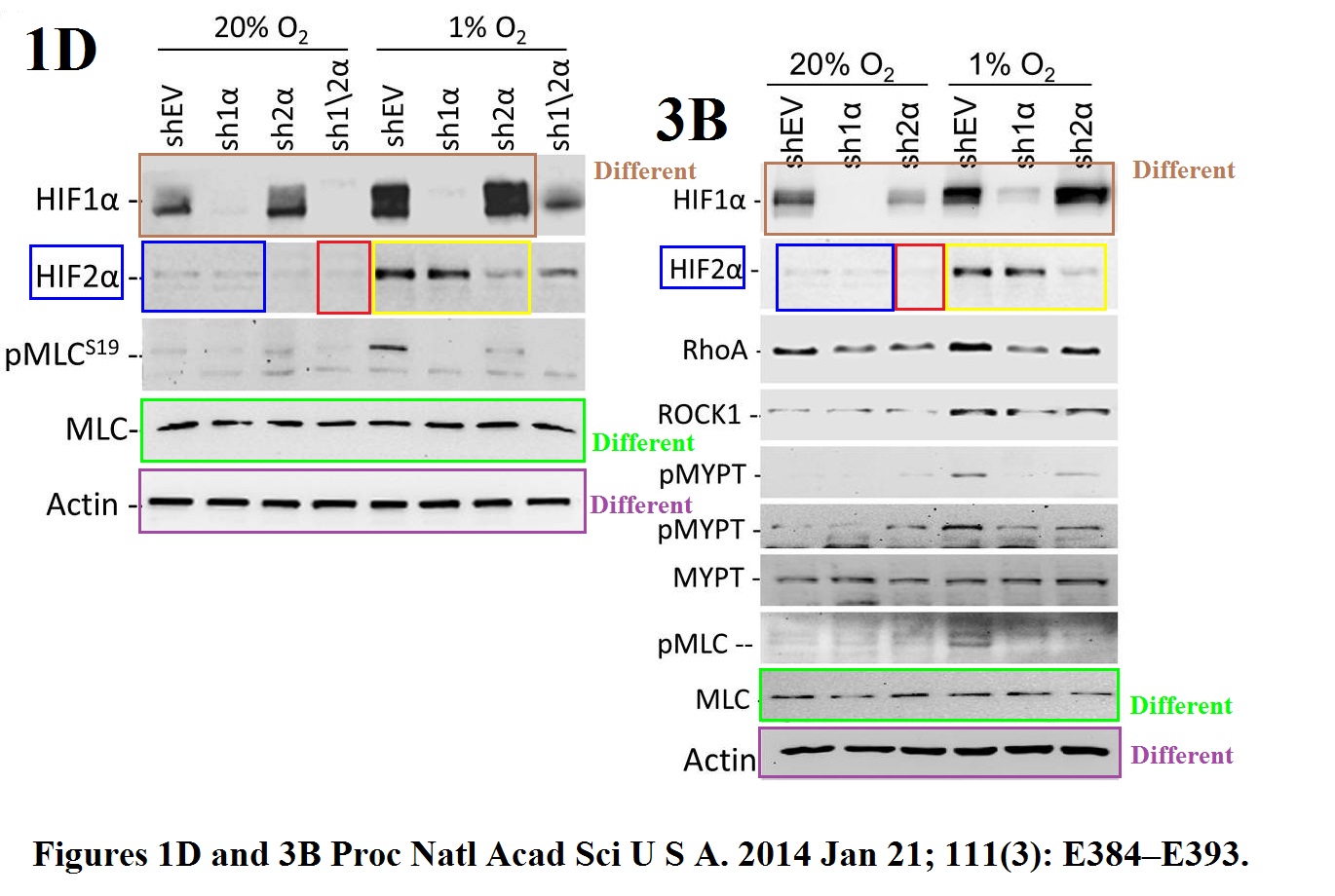
The HIF2a gel was reused, after some splicing, the sample labels remained same, except the red-boxed one. But why did the authors recycle only that gel, and not the loading control Actin, or HIF1a or pMLC? Maybe becasue the two figures show slightly different results for these?
The Figure 5C of the next Gilkes et al paper from Semenza lab was fixed in 2013, because it was “incorrect”. No details were provided by the journal, of which Semenza is deputy Editor-in-Chief, so here Clare Francis:
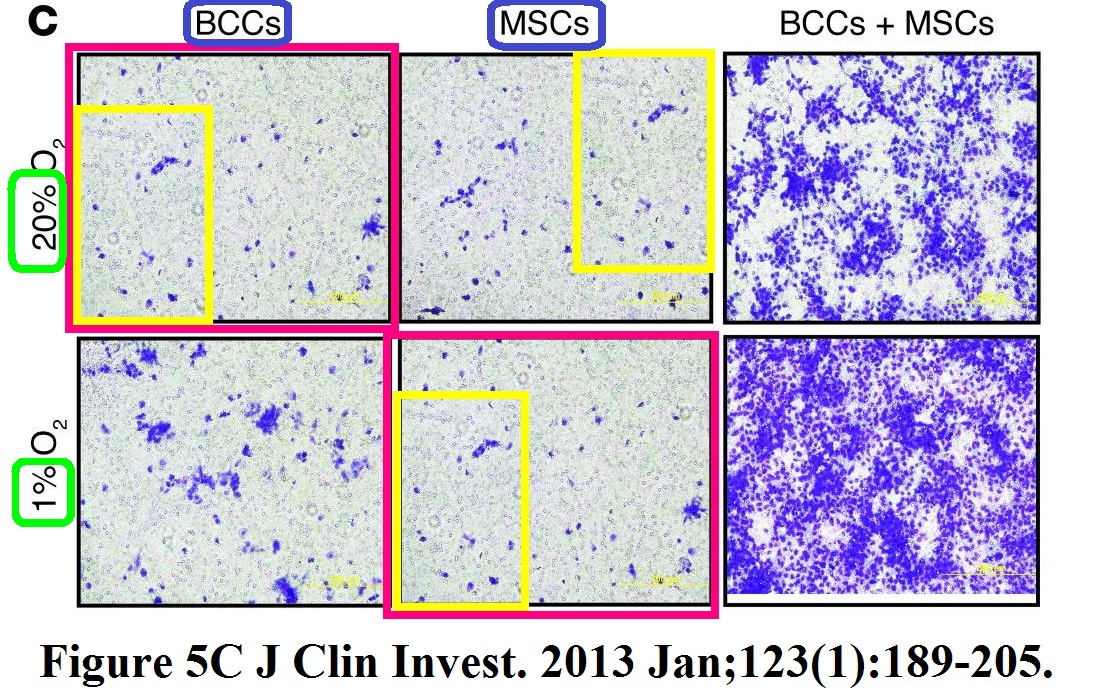
Pallavi Chaturvedi, Daniele M. Gilkes, Carmen Chak Lui Wong, Kshitiz, Weibo Luo, Huafeng Zhang, Hong Wei, Naoharu Takano, Luana Schito, Andre Levchenko, Gregg L. Semenza Hypoxia-inducible factor–dependent breast cancer–mesenchymal stem cell bidirectional signaling promotes metastasis The Journal of clinical investigation (2012) doi: 10.1172/jci64993
Semenza’s deputy Chief Editor colleague at JCI, Arturo Casadevall, is an internationally celebrated champion of research ethics, but only in theory, e.g. it does not seem to apply to his own papers.
When the Nobelist was interviewed in January 2020 about his work as JCI Deputy chief editor, by his editorial board colleague Elyse Dankoski, she somehow mentioned that “JCI’s current editorial board seems committed to tackling problems in scientific publishing, such as bias in first authorship as well as data manipulation issues“. I wonder if Semenza winced, or chuckled darkly. He was also asked: “Can you share any insights into what you’re looking for when you evaluate a submitted article?“.
The reply was hilarious:
“Pretty simple, just answer two questions:
Is this work novel and impactful?
Do the results adequately support the conclusions?“
Do you, dear reader, think those cloned gel bands were sufficiently novel and impactful and do they affect the conclusions of Nobel Prize winning papers from the Johns Hopkins lab of Dr Semenza?
Let me show you a bit more, now some collaborative research.
For example, there was a collaboration of Semenza with Nanduri Prabhakar of University of Chicago. Prabhakar even wrote an editorial on the occasion of Semenza’s Nobel Prize in the society journal Physiology. All three papers below have the same first author Guoxiang Yuan from Chicago, but would they have been published in these journals if not for Semenza’s significant coauthorship? Not in PNAS for sure, where Semenza “contributed” the paper to bypass peer review.
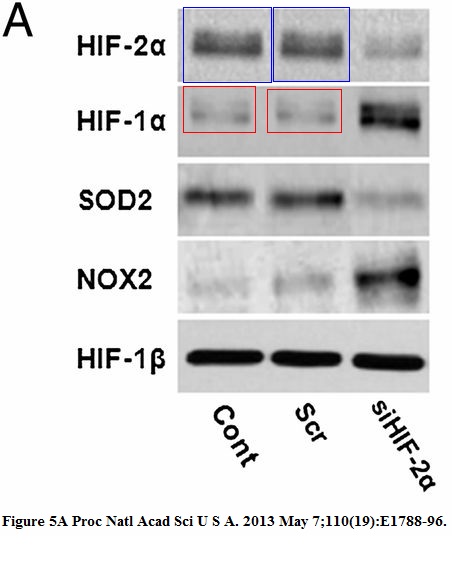

All these copy-pasted gel bands are depressing. But even more depressing is the knowledge that none of these three journals is likely to retract them, or to do anything in the first place. Because Semenza won the Nobel Prize.
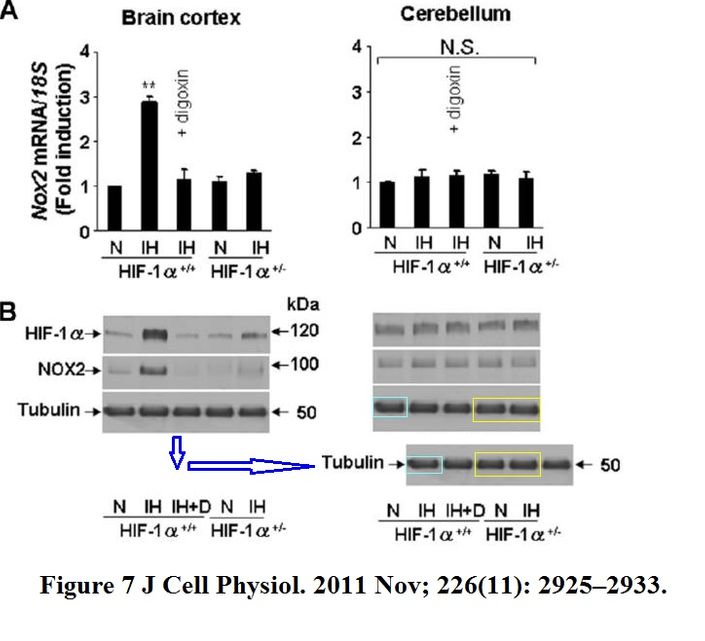
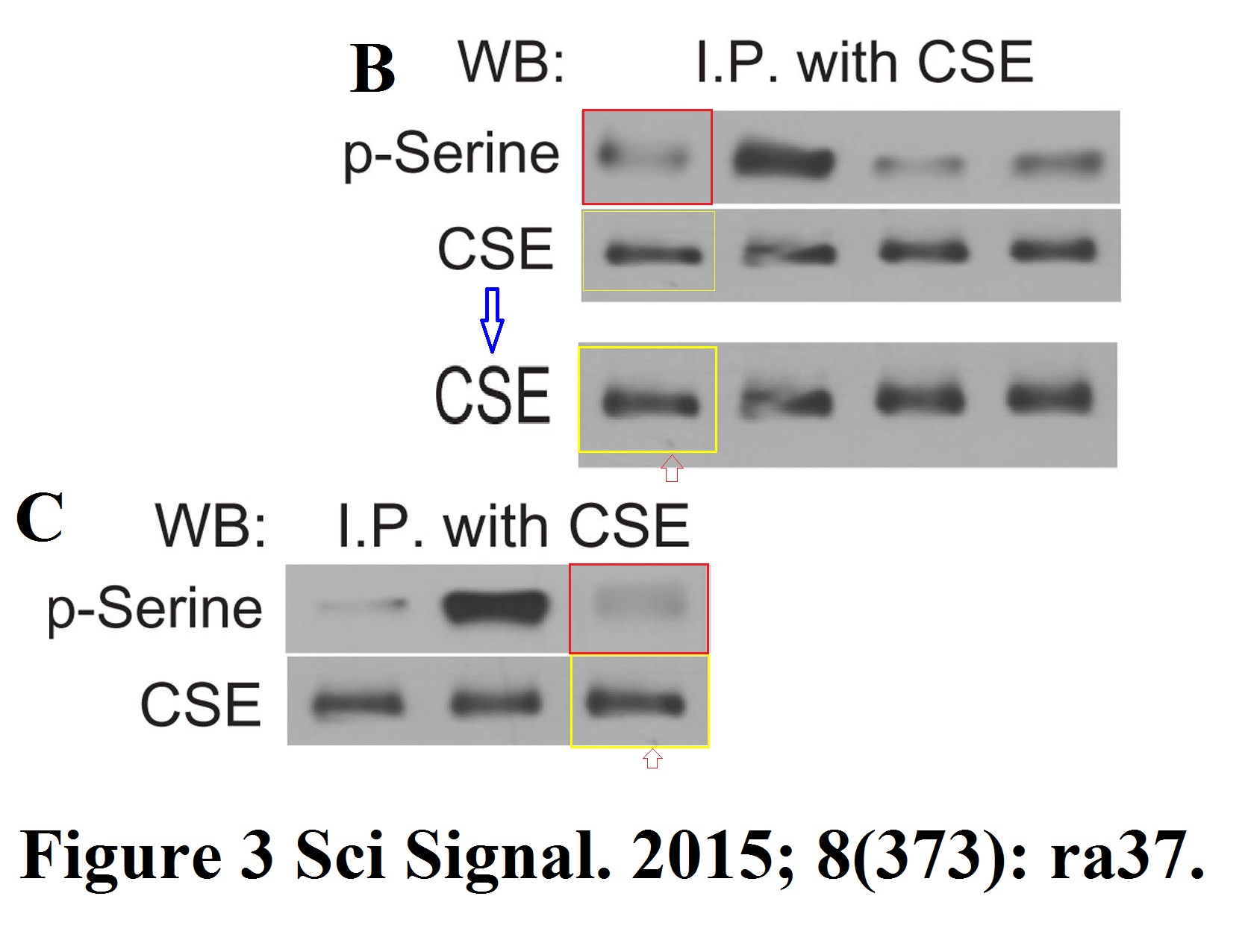
There were certainly strange things going on in Semenza’s lab. The following might look like a misunderstanding, or a mistake, but seems to be more sinister:
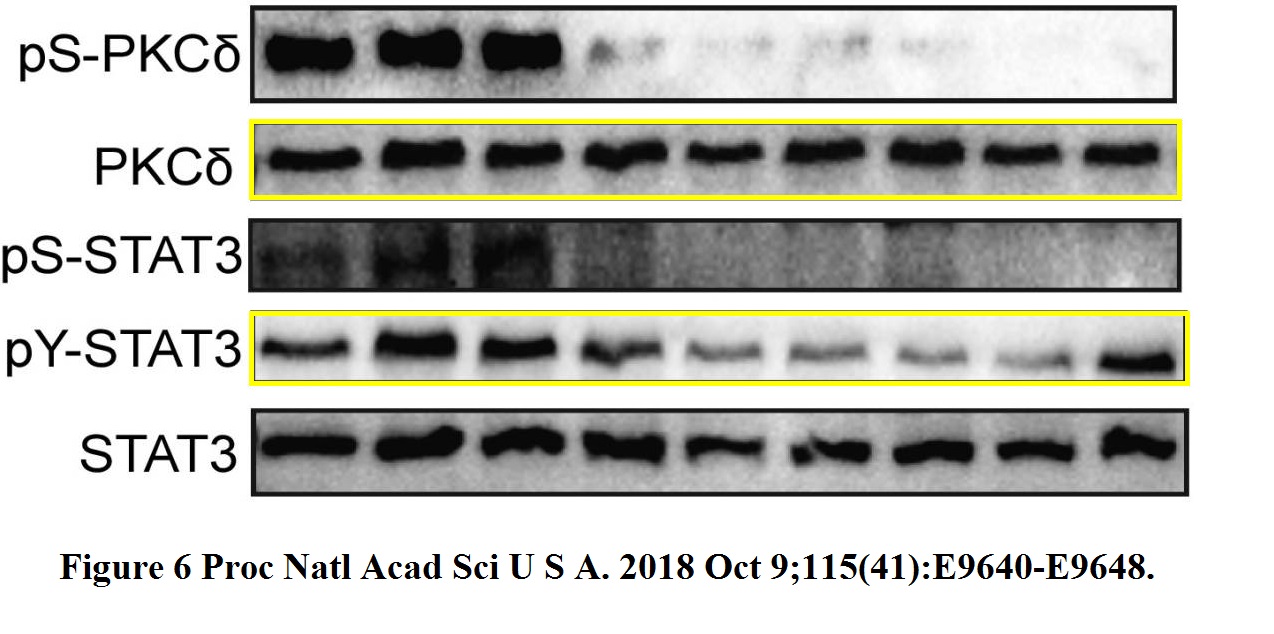
Jie Lan, Haiquan Lu, Debangshu Samanta, Shaima Salman, You Lu, Gregg L. Semenza Hypoxia-inducible factor 1-dependent expression of adenosine receptor 2B promotes breast cancer stem cell enrichment Proceedings of the National Academy of Sciences of the United States of America (2018) doi: 10.1073/pnas.1809695115
There should be two gels, one probed for PKCdelta (total and phosphorylated) and another probed for STAT3 (total and phosphorylated). But the PKCdelta and pY-STAT3 bands are so similar they must have come from same gel. Is the declared pY-STAT3 signal really the pS-PKCdelta signal? In this case, what happened to the correct pY-STAT3 gel, and what are the other gels really showing then? This cannot happen by mistake. Luckily, also this PNAS paper was contributed by Semenza, so there is no case, as far as the journal is concerned.
When the discoverer of the HIF proteins received his Nobel Prize phone call, he said:
“Yeah, well certainly nobody expects that, that’s for sure. Even after people have been telling you for, you know, 20 years or more that it’s going to happen, no one expects it.“
He might have expected the Nobel, but did Semenza expect Clare Francis?
Another collaborative paper with a similar problem prompted one Cell Press editor to admit he either has no clue of molecular biology, or does not care a bit about basic data integrity.
De Huang, Tingting Li, Xinghua Li, Long Zhang, Linchong Sun, Xiaoping He, Xiuying Zhong, Dongya Jia, Libing Song, Gregg L. Semenza, Ping Gao, Huafeng Zhang HIF-1-mediated suppression of acyl-CoA dehydrogenases and fatty acid oxidation is critical for cancer progression Cell Reports (2014) doi: 10.1016/j.celrep.2014.08.028
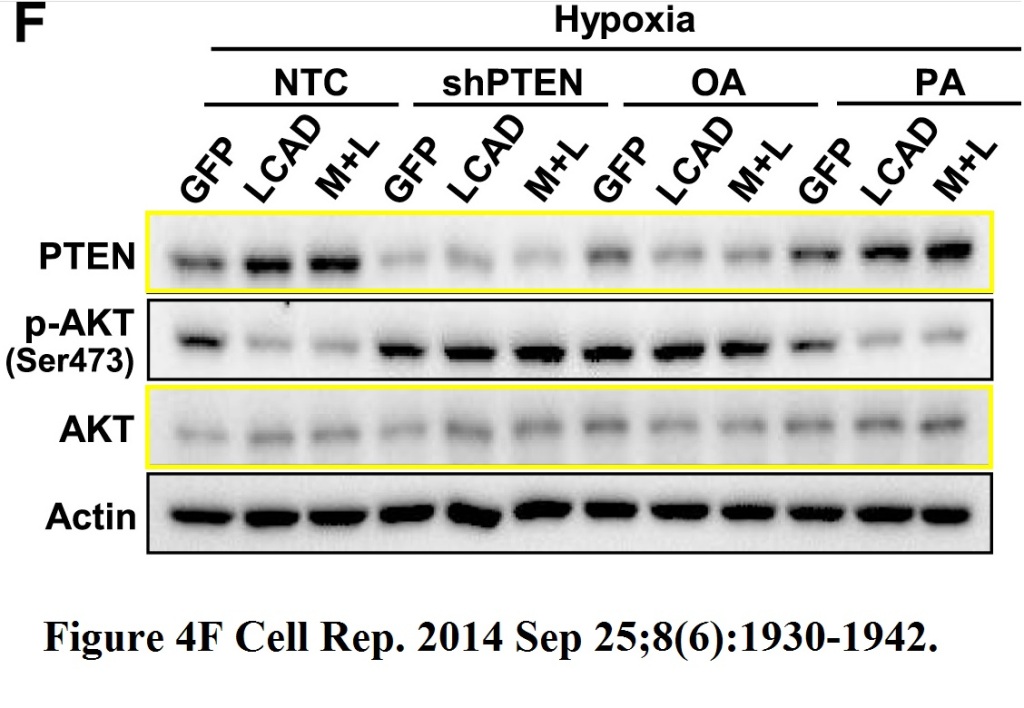
Basically, the phospho-AKP blot comes from a different gel for which no loading control was done. Stephen Matheson, Editor-in-Chief of Cell Reports, wrote to Clare Francis:
“I agree, but I don’t think those at all need to be from the same blot. This is not problematic.“
That is only partially correct, Steve. There can be indeed more than one gel, but each of those must be supplied with its own loading control. How do you know that for the p-AKT gel the same amount of protein lysate was loaded in, say, lane 1 as opposed to lane 2 and 3, or lane 4? Answer: blind trust because one of the authors went on to win a Nobel Prize. Semenza is by the way the only non-China-based author on that paper, you can guess what his actual contribution was. Yes, I am aware that gift authorships are a form of scientific misconduct. But see, it helped not only to get that paper published in a Cell family journal, but also to get it to remain published there.
As it will have helped another Cell Press paper, this time from South Korea, where Semenza’s name again stands out like a sore thumb, as the only contributor from Johns Hopkins.
Jason S. Lee, Yunho Kim, Ik Soo Kim, Bogyou Kim, Hee June Choi, Ji Min Lee, Hi-Jai R. Shin, Jung Hwa Kim, Ji-Young Kim, Sang-Beom Seo, Ho Lee, Olivier Binda, Or Gozani, Gregg L. Semenza, Minhyung Kim, Keun Il Kim, Daehee Hwang, Sung Hee Baek Negative regulation of hypoxic responses via induced Reptin methylation Molecular cell (2010) doi: 10.1016/j.molcel.2010.06.008
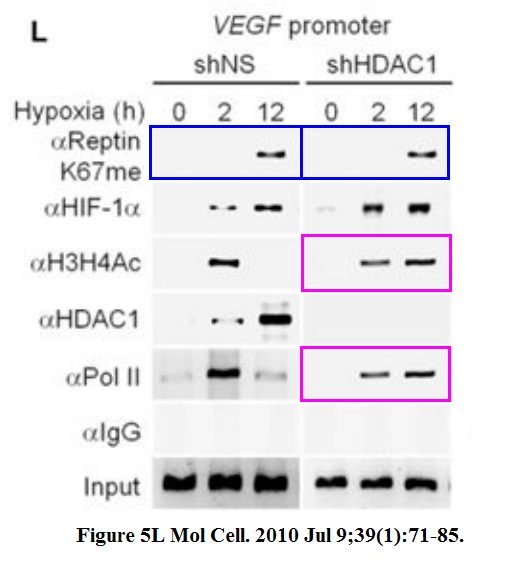
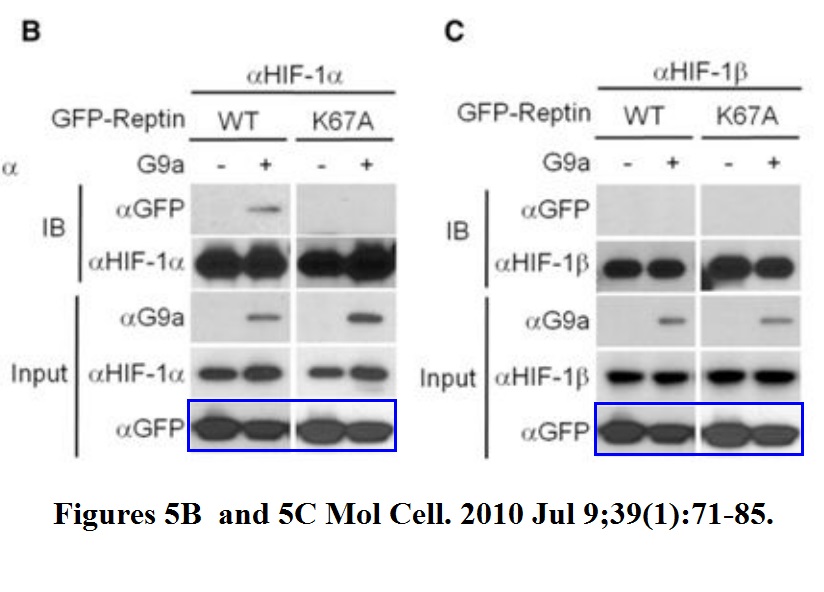
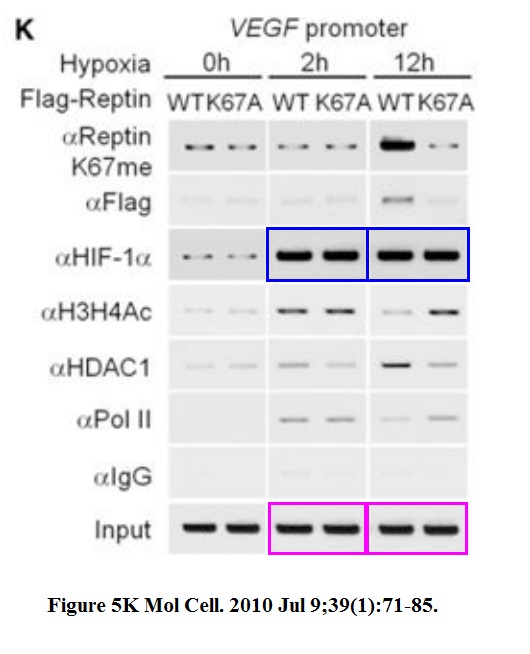
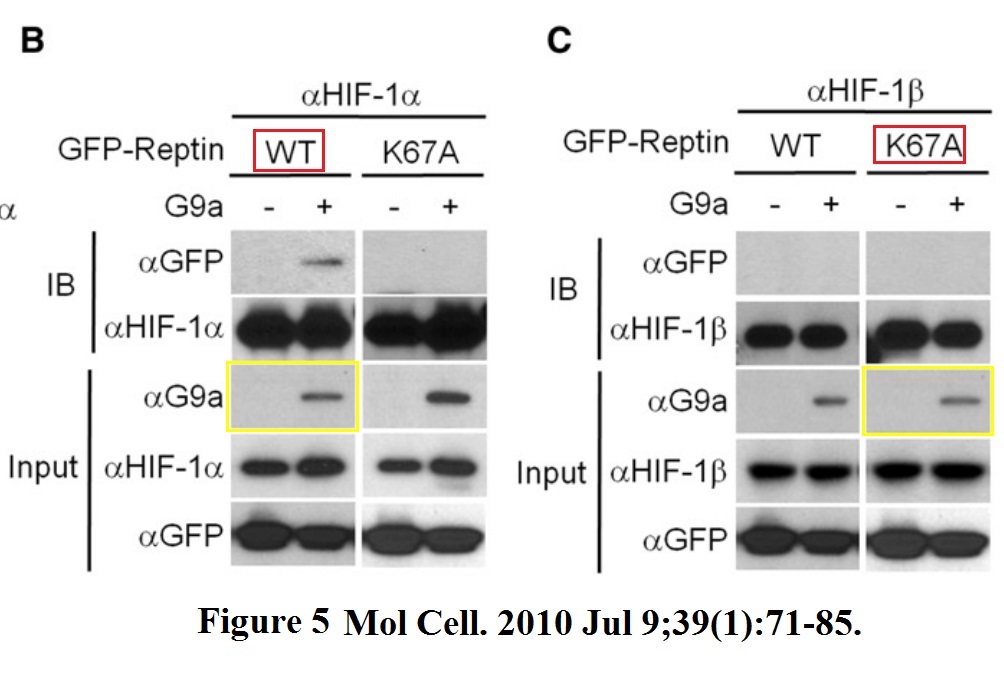
Nobody, absolutely nobody at Molecular Cell will have any problem with this. This is a journal which rejects retraction requests from universities. Maybe this is a good opportunity to wonder, sure, Cell Press and Elsevier in general does not give a flying toss about falsified data, but how about torturing small animals? Is it their thing also? Does it get them off or will they finally get off their bums and do something about scientific malpractice? Don’t hold your breath. Have a look at what was done to these mice:
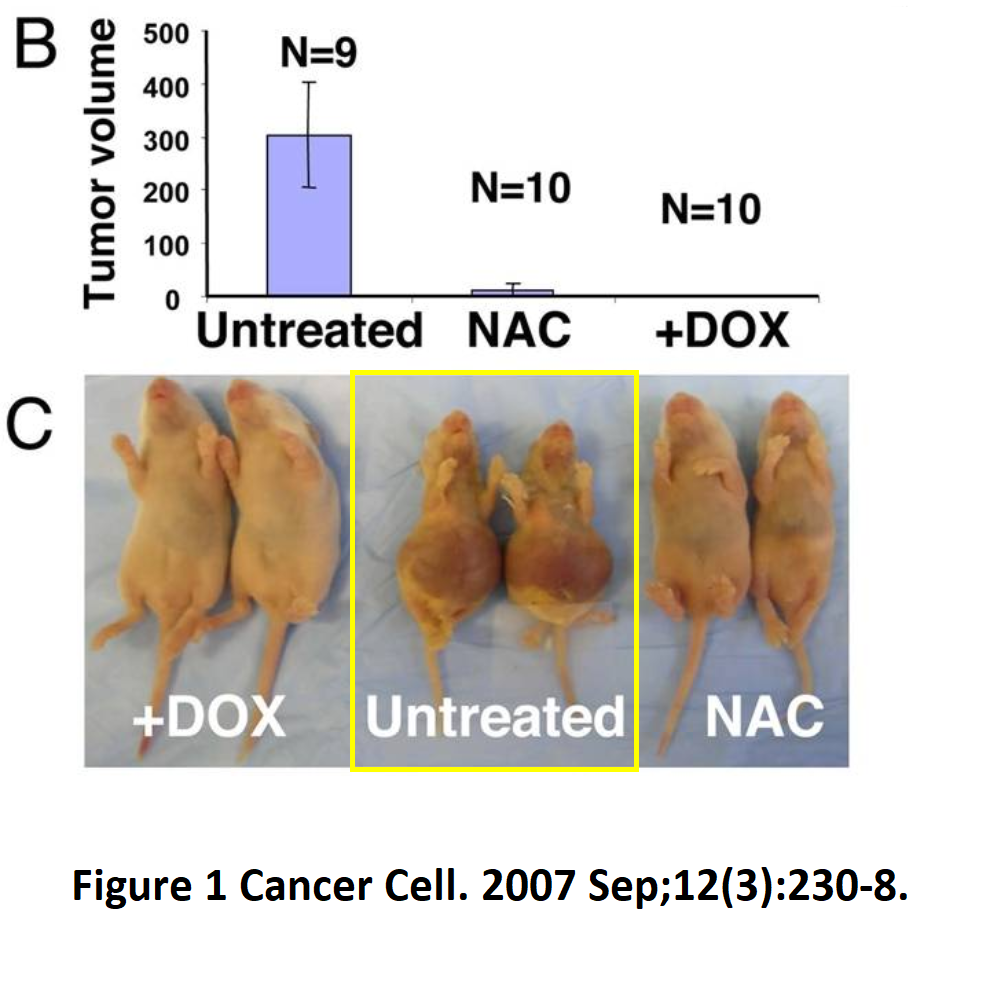
Ping Gao, Huafeng Zhang, Ramani Dinavahi, Feng Li, Yan Xiang, Venu Raman, Zaver M. Bhujwalla, Dean W. Felsher, Linzhao Cheng, Jonathan Pevsner, Linda A. Lee, Gregg L. Semenza, Chi V. Dang HIF-dependent antitumorigenic effect of antioxidants in vivo Cancer Cell (2007) doi: 10.1016/j.ccr.2007.08.004
This animal research work was done at Johns Hopkins. Did nobody really notice that the xenograft tumours grew so huge that the animals must have horribly suffered? That the nude mice should have been euthanised long before the tumours became this big, as per standard animal experimenting guidelines in USA? The authors failed there, and so did the editors and peer reviewers. Will something happen to this Cancer Cell paper now? Don’t be silly, Semenza won the Nobel Prize.
Better let’s look at some cloned western blot bands again, those are at least funny. Here some older stuff Semenza published with Kiichi Hirota, now professor at Kansai Medical University in Japan.
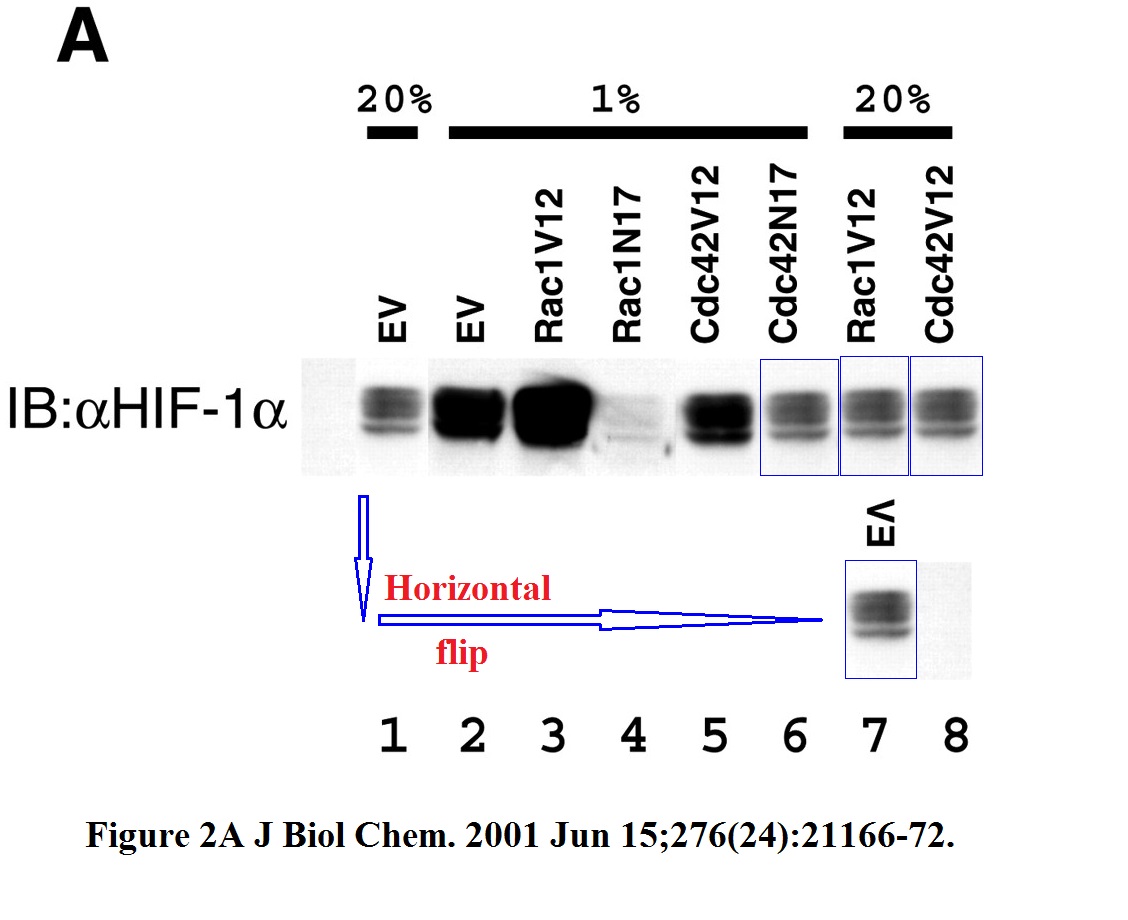
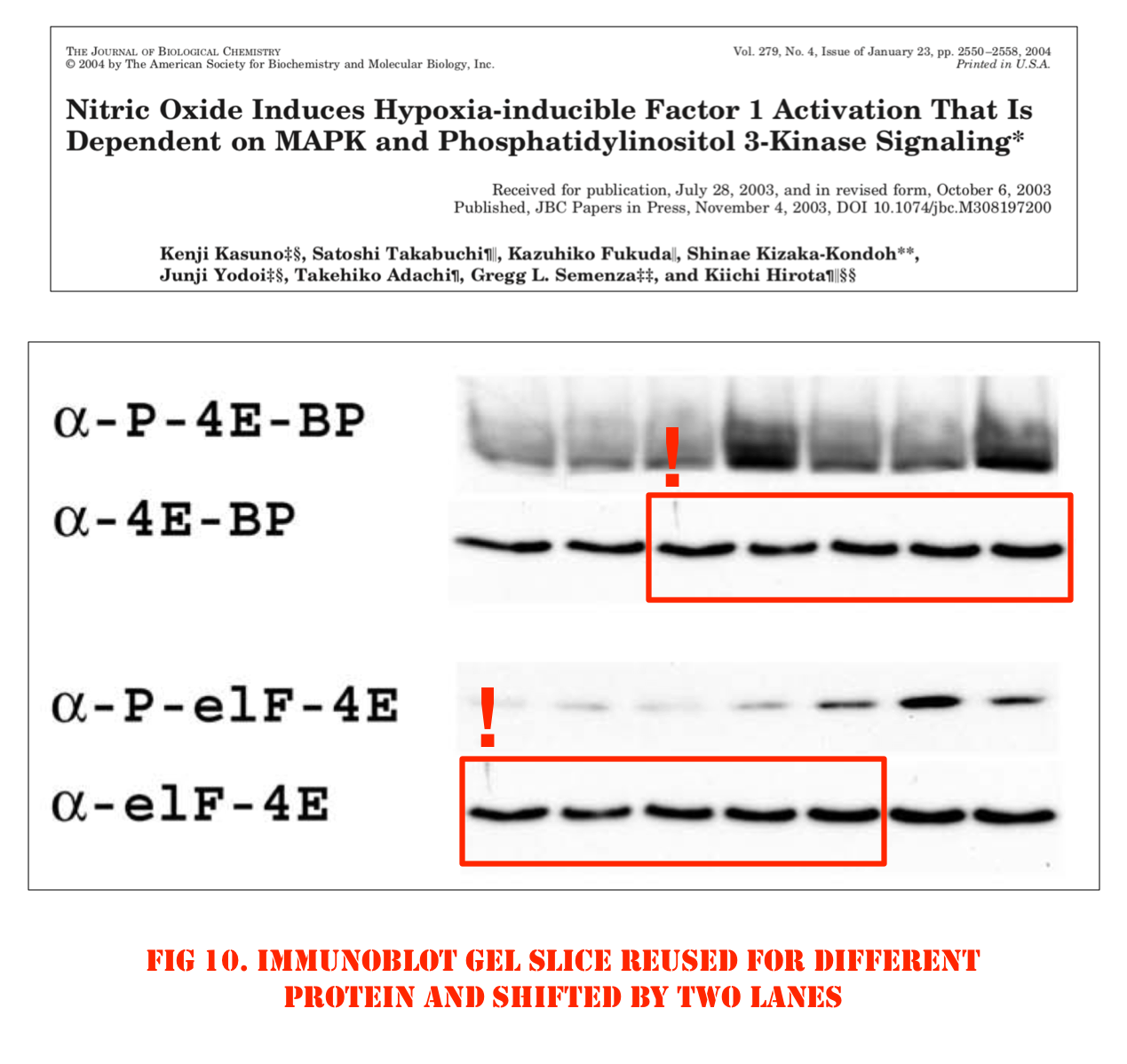
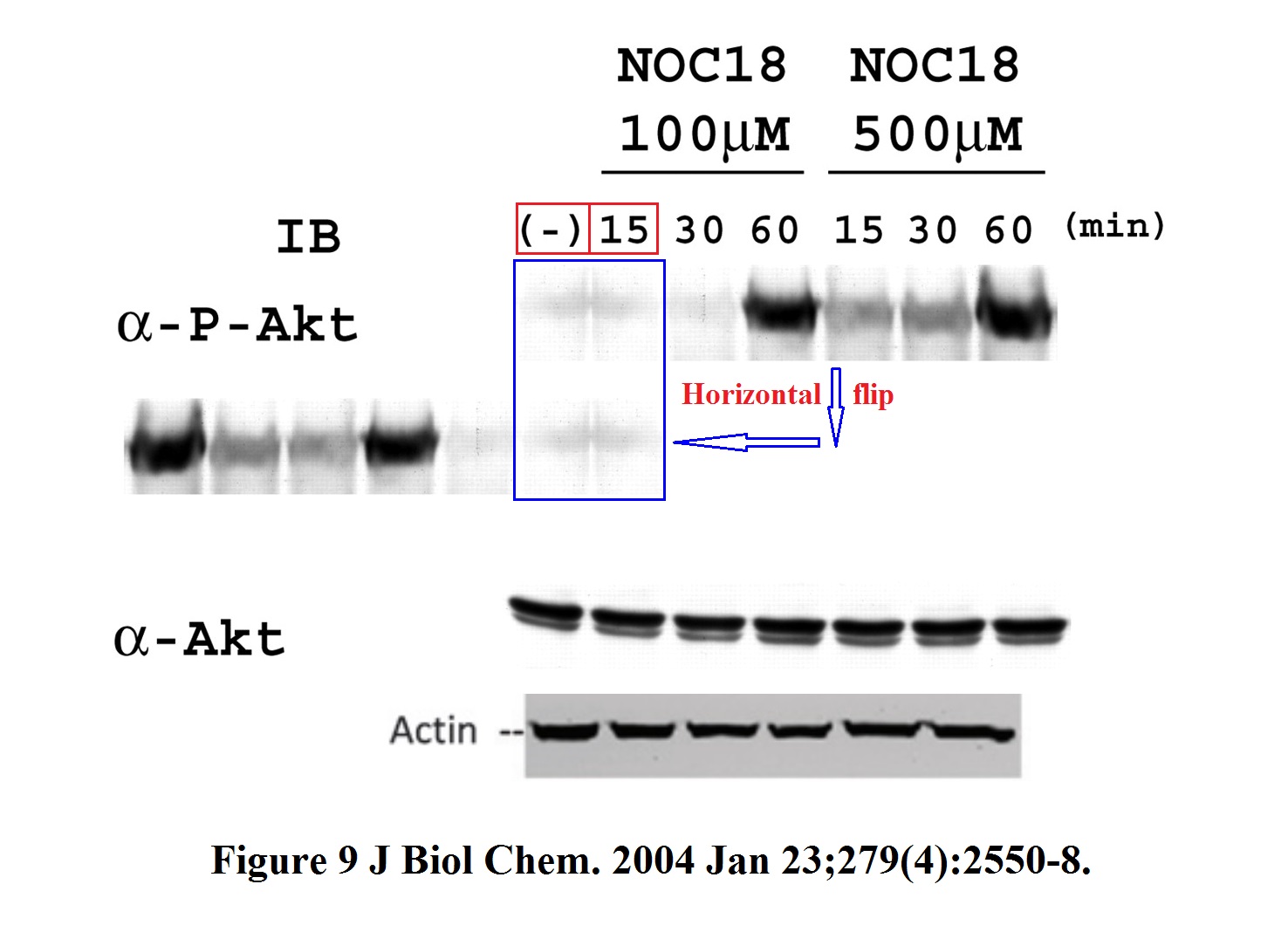
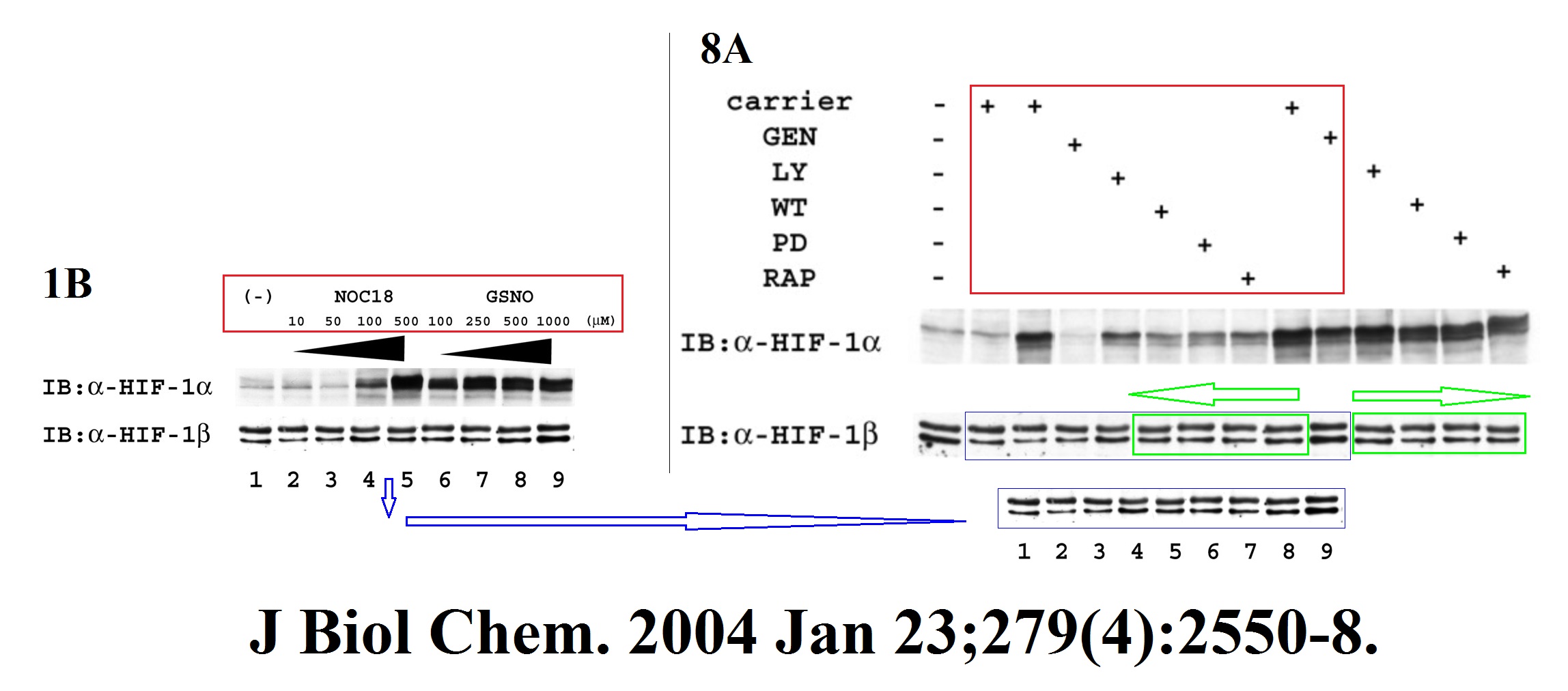
Hirota (“my h-index is “49“) became Semenza’s collaborator when the former joined Johns Hopkins School of Medicine as visiting professor in 1999-2002. In this regard, also this study in Nature Genetics, where a gel was falsified:
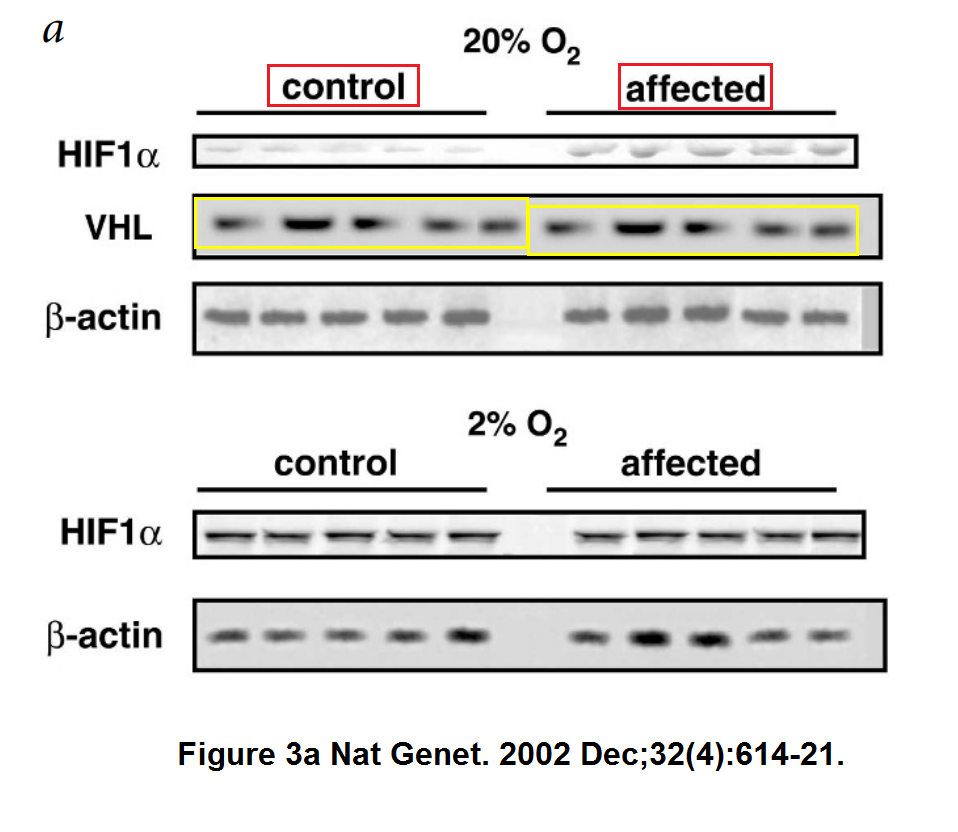

So far, Semenza had one retraction, in 2011 and with some other Japanese colleagues, for Tomita et al Biochemical Journal 2007. Back then the notice said “The last author, Naoki Mori, takes full responsibility for the misrepresentation of data in this paper“.

When he won the Nobel Prize, Semenza said in an interview with ACS magazine c&en:
“All science is a collaborative effort. I have all these hardworking postdocs and graduate and undergraduate students in the lab. Everybody works together as a team. I have a really fine group of people who work in the lab. My major criterion for picking people is that they’re really nice to work with because we spend a lot of time together.“
You took the responsibility for their work when accepting your Nobel Prize and other awards, Professor Semenza. Time to take responsibility for the fabricated figures your team published.
Update 8.10.2020
Johns Hopkins University confirmed to me to be aware of the issues. Meanwhile, Clare Francis resumed checking Semenza’s publications (see comment section). One is worth posting here, because it is another PNAS contributed paper, where one of the friendly reviewers Semenza hand-picked was…. Maria Alfonsina Desiderio, from University of Milan, Italy. Remember her? Desiderio has 5 retractions now, for data fakery.
This is the paper:
Debangshu Samanta, Daniele M. Gilkes, Pallavi Chaturvedi, Lisha Xiang, and Gregg L. Semenza Hypoxia-inducible factors are required for chemotherapy resistance of breast cancer stem cells PNAS (2014) doi: 10.1073/pnas.1421438111

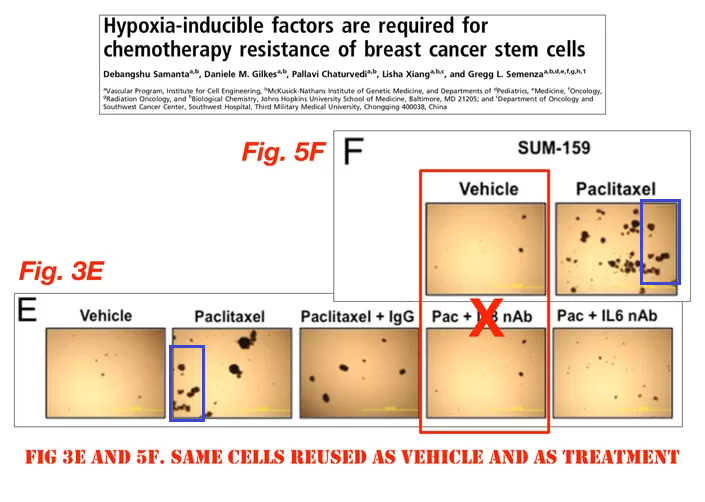
Update 10.10.2020
This gets worse and worse. Another one contributed by Semenza to PNAS:
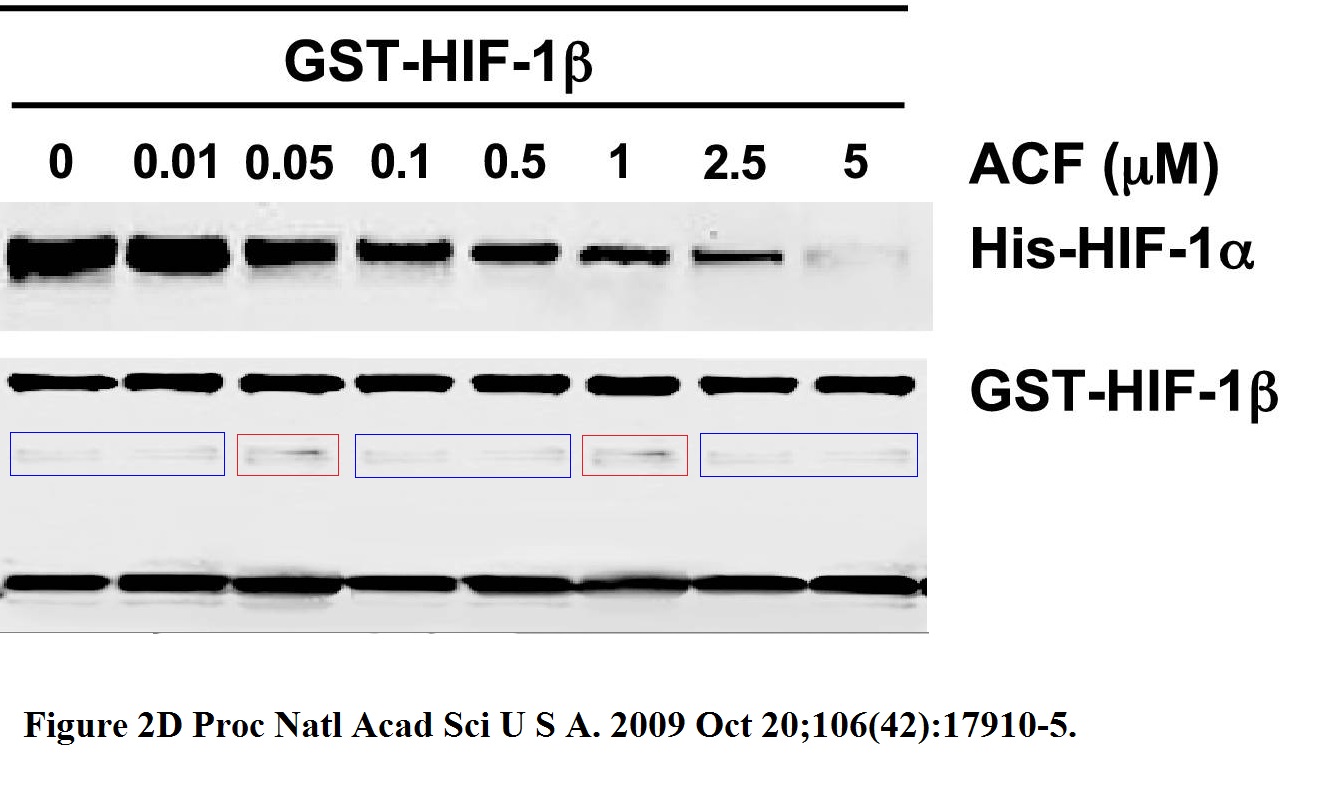
KangAe Lee, Huafeng Zhang, David Z Qian, Sergio Rey, Jun O Liu, Gregg L Semenza Acriflavine inhibits HIF-1 dimerization, tumor growth, and vascularization Proceedings of the National Academy of Sciences (2009) doi: 10.1073/pnas.0909353106
Someone erased all the lower gel bands, as evidenced by the cloned fragments. Does this affect the conclusions? It sure does, very much. And how about this, by similar author collective (yes, also contributed by Semenza):
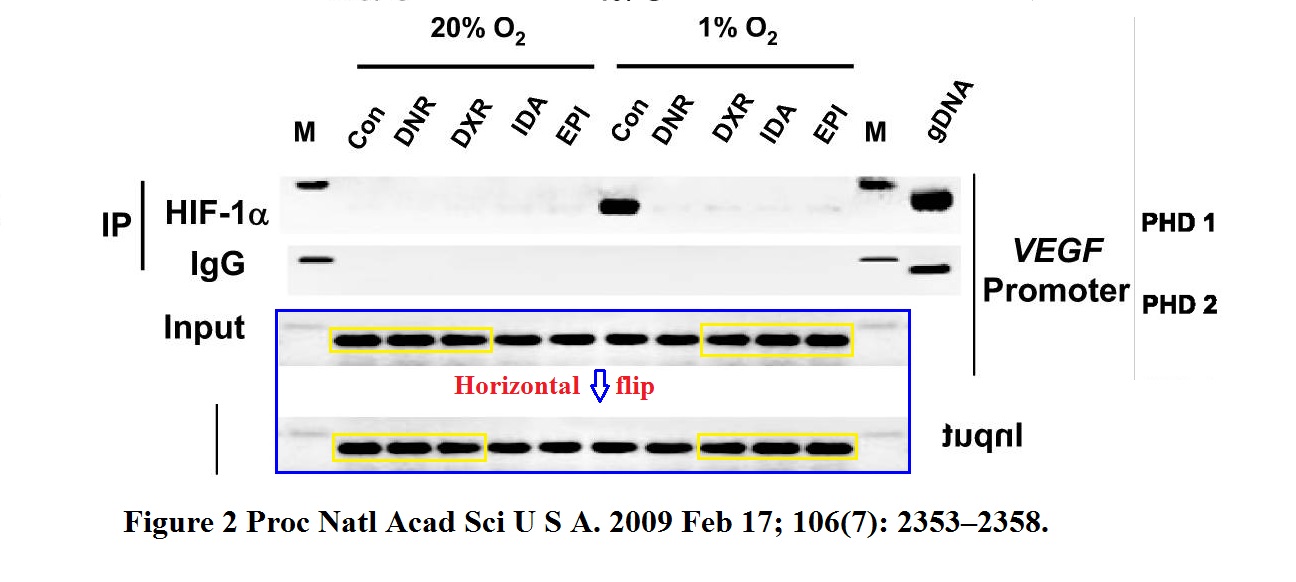
KangAe Lee, David Z Qian, Sergio Rey, Hong Wei, Jun O Liu, Gregg L Semenza Anthracycline chemotherapy inhibits HIF-1 transcriptional activity and tumor-induced mobilization of circulating angiogenic cells Proceedings of the National Academy of Sciences (2009) doi: 10.1073/pnas.0812801106

Someone commented on PubPeer: “I think the whole row is a mirror“. It does look like a falsified loading control. In the same paper, mouse images are sometimes strangely similar, as if that mouse was imaged just seconds and not days apart as the study description claims. The first author, KangAe Lee is now at Princeton University, here is another classic of hers flagged by Clare Francis.
Did you perchance also have trouble reproducing Semenza’s research results, as some of my readers already complained?
Update 14.10.2020
The treasure hunt continues! This article became popular with Japanese readers, so here a collaborative paper of Hirota and others, where Semenza will probably now regret to have agreed to signing as coauthor:
Tomoyuki Oda, Kiichi Hirota, Kenichiro Nishi, Satoshi Takabuchi, Seiko Oda, Hiroko Yamada, Toshiyuki Arai, Kazuhiko Fukuda, Toru Kita, Takehiko Adachi, Gregg L. Semenza, Ryuji Nohara Activation of hypoxia-inducible factor 1 during macrophage differentiation AJP Cell Physiology (2006) doi: 10.1152/ajpcell.00614.2005
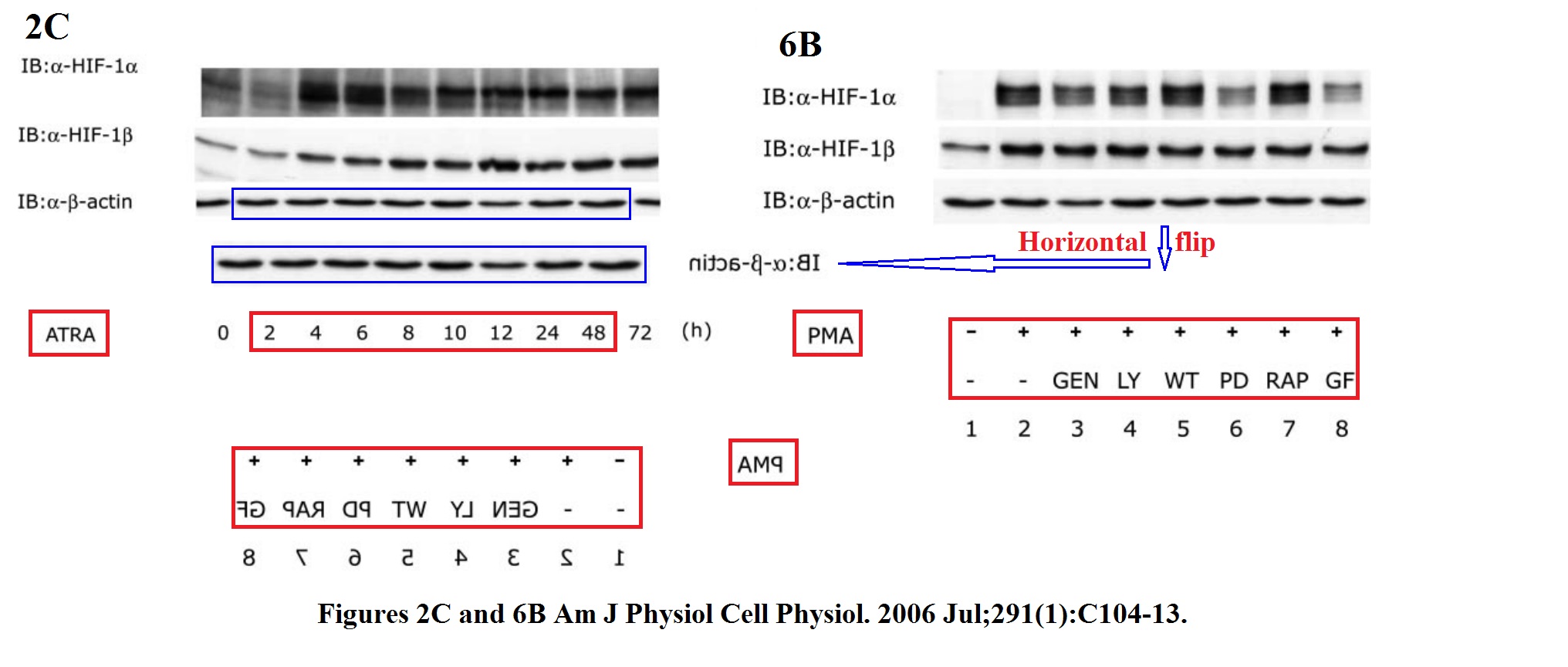
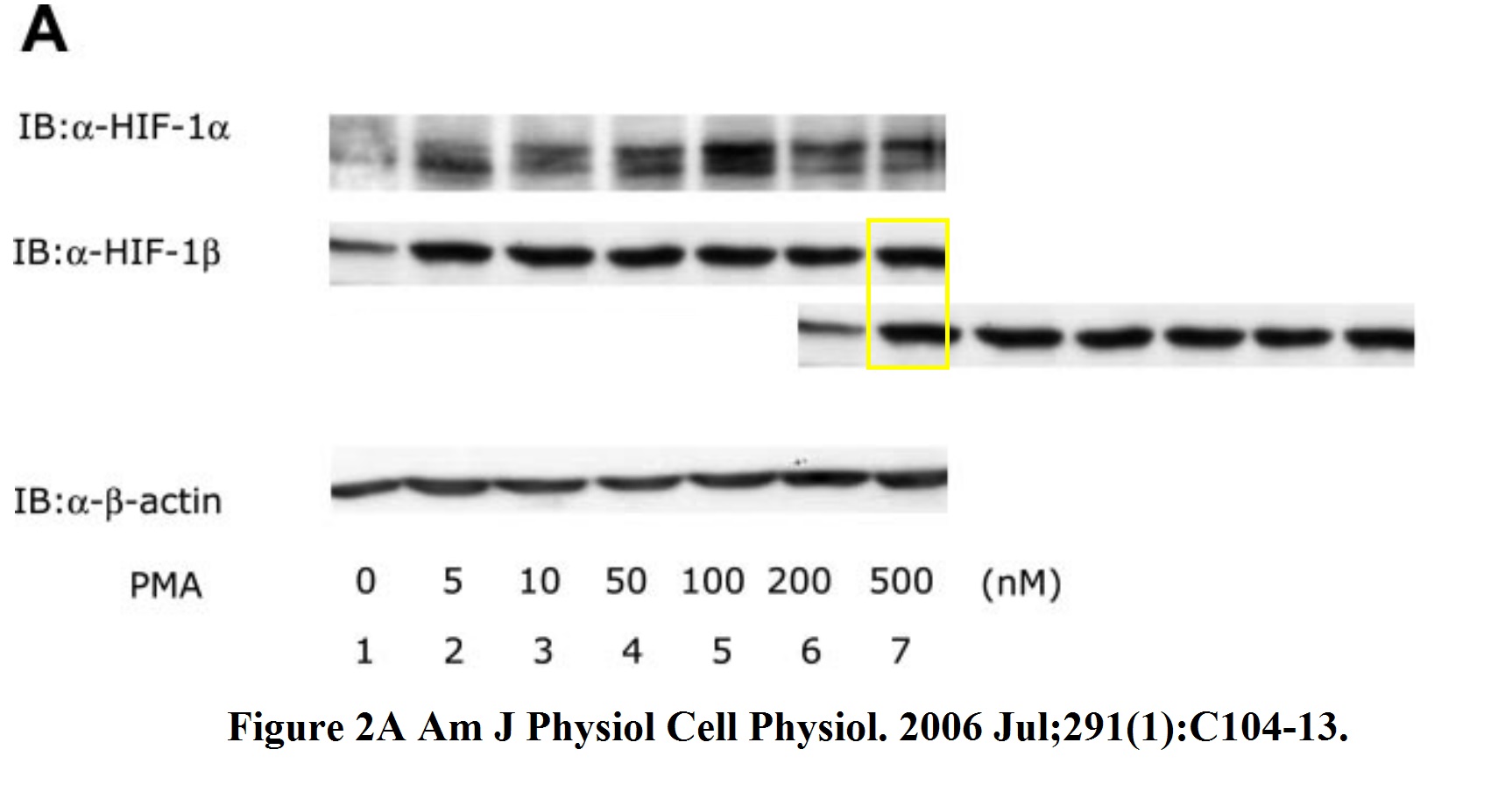
From Japan to China. Remember Huafeng Zhang, coauthor on several problematic papers from Semenza lab, and now professor at the University of Science and Technology of China in Hefei? Here another one:
Huafeng Zhang, Marta Bosch-Marce, Larissa A. Shimoda, Yee Sun Tan, Jin Hyen Baek, Jacob B. Wesley, Frank J. Gonzalez, Gregg L. Semenza Mitochondrial autophagy is an HIF-1-dependent adaptive metabolic response to hypoxia Journal of Biological Chemistry (2008) doi: 10.1074/jbc.m800102200
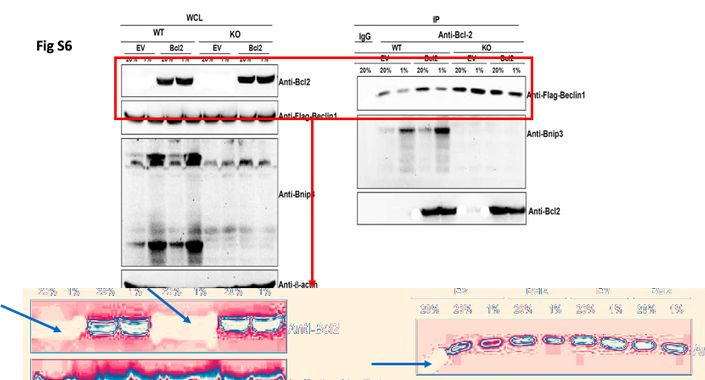
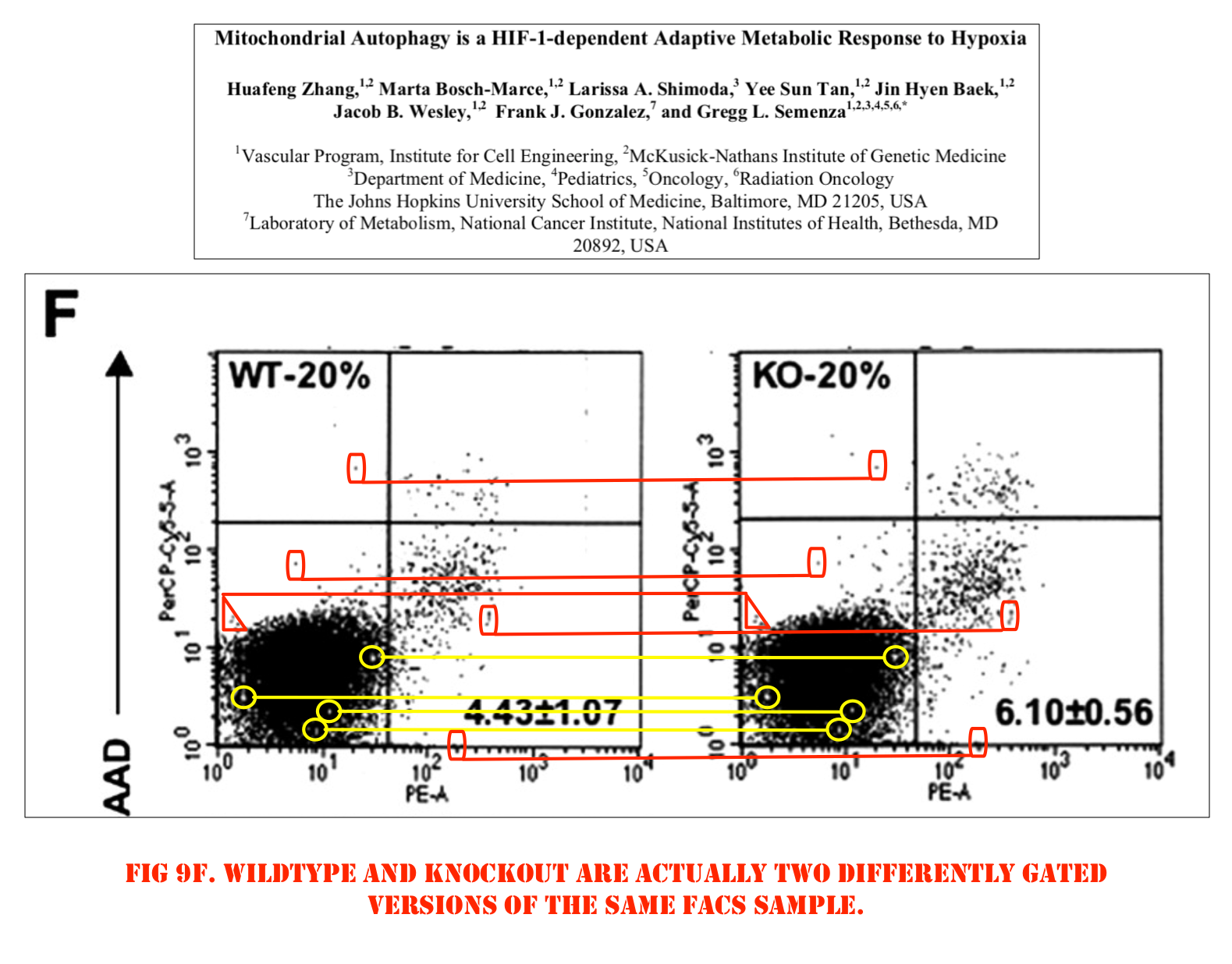
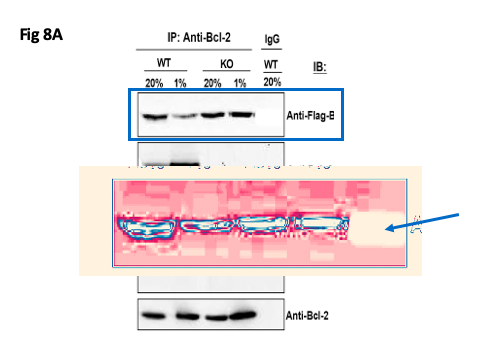
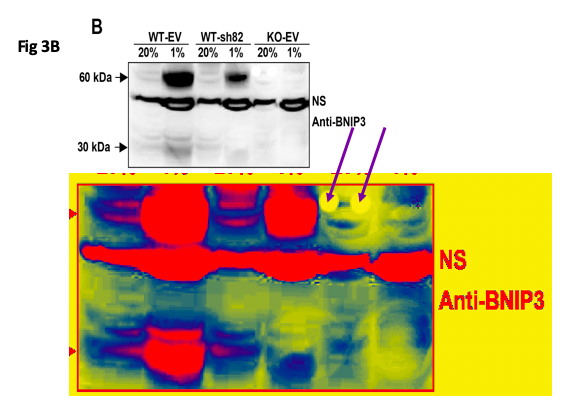
Update 17.10.2020
Welcome to the new episode of Gregg’s Photoshop Adventures. By now, first media reported, NRC (in Dutch). Recall the Gilkes et al Cancer Research 2013 paper briefly flagged at the very beginning above, for data reuse? It’s worse, than originally thought; contributed by Elisabeth Bik:

Daniele M Gilkes, Pallavi Chaturvedi, Saumendra Bajpai, Carmen C Wong, Hong Wei, Stephen Pitcairn, Maimon E Hubbi, Denis Wirtz, Gregg L Semenza Collagen prolyl hydroxylases are essential for breast cancer metastasis Cancer Research (2013) doi: 10.1158/0008-5472.can-12-3963
Update 19.10.2020
There are presently over 40 Semenza papers on PubPeer with serious concerns raised. Here a somewhat fresh one, for Cell Press to do diddly-squat about, as part of their advertisement programme for the ethically challenged among scientists:
Haiquan Lu, Ivan Chen, Larissa A. Shimoda, Youngrok Park, Chuanzhao Zhang, Linh Tran, Huimin Zhang, Gregg L. Semenza Chemotherapy-Induced Ca 2+ Release Stimulates Breast Cancer Stem Cell Enrichment Cell Reports (2017) doi: 10.1016/j.celrep.2017.02.001
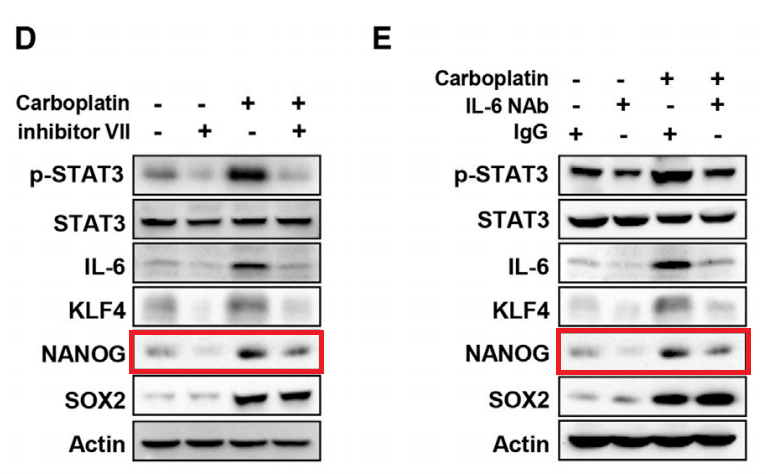
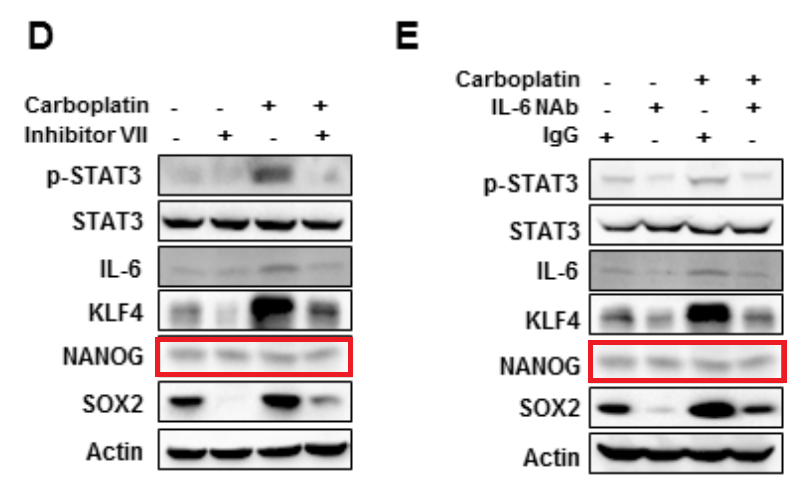
Very lazy approach, also the loading controls (STAT3, Actin) were from a “library”, and not from the same gel.
This is the oldest Semenza paper flagged so far, it is likely to be part of the Nobel Prize qualification:
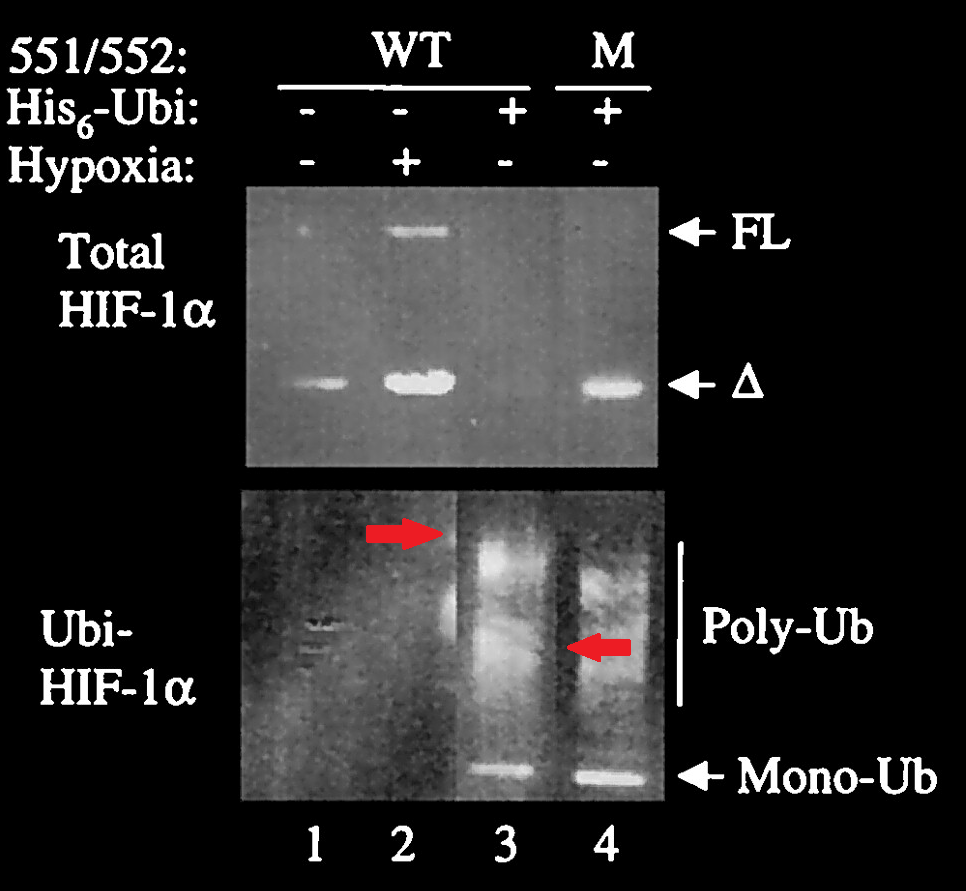
C. H. Sutter , E. Laughner , G. L. Semenza Hypoxia-inducible factor 1alpha protein expression is controlled by oxygen-regulated ubiquitination that is disrupted by deletions and missense mutations Proceedings of the National Academy of Sciences of the United States of America (2000) doi: 10.1073/pnas.080072497
Apparently, someone disagreed with the signal in the third lane, so it was overlaid with “better” results.
Jonathan Links, Vice Provost and Research Integrity Officer at Johns Hopkins University, replied to me again:
“I am acknowledging receipt of this additional information. I am reiterating what I told you previously: Please refer to the Johns Hopkins University Research Integrity policy—which I provided to you previously. Johns Hopkins will adhere to the federal research misconduct regulations and the provisions of that policy, which specifically address confidentiality.“
The policy is here, its procedure stipulates the appointment of an internal inquiry by the Hopkings School of Medicine before deciding on a formal investigation. I however do not know how the faculty can find anyone with “unresolved personal, professional or financial conflicts of interest” in such a high profile case.

Donate!
If you are interested to support my work, you can leave here a small tip of $5. Or several of small tips, just increase the amount as you like (2x=€10; 5x=€25). Your contribution to getting the Nobel prize abolished.
5.00 €


The whole entire scientific system must be reformed. As other prizes, awards and funding for science the Nobel Prize must be reformed also. Raw data should be deposited in an international bank accessible to anyone, Adobe Photoshop should be banned from science. Otherwise, the Nobel Prize will be soon regarded as the prize of the fool.
LikeLiked by 1 person
“Adobe Photoshop should be banned from science”. I think it is, most journals ban the use of Adobe Photoshop, but this is not science.
Versions of Adobe Photoshop have been commercially available since February 1990, but most people reassure themselves by thinking it has only been around since the early to mid-2000s.
LikeLike
The best process to follow would be double-blind peer-review. However, most established scientists and those from prestigious universities who reap the benefits of the current system would oppose it the most because it would quite rock their boat. And these are the Ediotrs of most journals. So, we won’t see any change soon in future.
LikeLike
” double-blind peer-review”. That would also put the journals to the test.
I bet that all most editors do is look at is the institutional address, see if they recognise a “star name” from the firmament, and determine if it is a “hot topic”.
Scrutiny is beyond them as this site proves..
LikeLike
I recently had to follow up on a HIF-1a hypothesis (HIF-1a activated a certain gene’s transcription) the boss thought of that was supported by a paper from mainland China. I knew it was likely doomed from the start, and fortunately I rapidly developed evidence that it was wrong. My boss was pretty pissed off at me for lecturing him that most hypothesis, however well conceived, are usually wrong….biology is not celestial mechanics, its too unpredictable.
If I had said that his hypothesis was wrong because he was basing it from work out of mainland China, he would have fired me for being a racist. So I didn’t say that. Again, IMO, its a culture, not a race issue.
I have read Semenza early papers, and they seem to be pretty good, and I presume finding hypoxia inducible transcription factors was his idea. So I would imagine the Nobel is warranted.
Its just that unscrupulous post-docs in his lab know that all they need to do is to get a high impact paper to have a lifetime reward (great job they never will lose), and if the project is not working, the temptation is going to be strong….
LikeLike
Well you do seem to be a bit racist. I don’t like Chinese Science either but you are clearly and completely blind to Semenza’s role and the extent of the fraud that is going on in American science.
LikeLike
I agree that Gregg Semenza did discover Hypoxia inducible factors, but there are many problematic papers with his name on them.
When the 2019 Nobel Prize for hypoxia inducible factors was announced my first reaction was what about Erythropoietin?
The discovery of hypoxia inducible factors built on the work of Erythropoietin so why not a Nobel Prize for the discovery and purification of Erythropoietin? The short answer is that it’s discoverer was dead by 2019, but it does seem an important discovery which has not received the recognition of hypoxia inducible factors
LikeLike
Peter J Ratcliffe, one of the other 2 to be awarded the 2019 Nobel Prize for Physiology or Medicine, might also check his own Pubpeer record.
Does Peter J Ratcliffe agree that there might be some problematic data. Could he follow through and correct the problematic data?
Does Peter J Ratcliffe agree that there should be one standard for everybody, not a lower standard for Nobel Prize laureates?
https://pubpeer.com/search?q=Peter+J+Ratcliffe
LikeLike
Cancer Res. 2016 Aug 1;76(15):4430-42. doi: 10.1158/0008-5472.CAN-16-0530. Epub 2016 Jun 8.
Expression Is Required for Mitochondrial Redox Homeostasis, Breast Cancer Stem Cell Maintenance, and Lung MetastasisDebangshu Samanta 1, Youngrok Park 2, Shaida A Andrabi 3, Laura M Shelton 4, Daniele M Gilkes 5, Gregg L Semenza 6Affiliations collapseAffiliations1Institute for Cell Engineering, Johns Hopkins University School of Medicine, Baltimore, Maryland. McKusick-Nathans Institute of Genetic Medicine, Johns Hopkins University School of Medicine, Baltimore, Maryland.2Institute for Cell Engineering, Johns Hopkins University School of Medicine, Baltimore, Maryland.3Institute for Cell Engineering, Johns Hopkins University School of Medicine, Baltimore, Maryland. Department of Neurology, Johns Hopkins University School of Medicine, Baltimore, Maryland.4Human Metabolome Technologies America, Inc., Boston, Massachusetts.5Institute for Cell Engineering, Johns Hopkins University School of Medicine, Baltimore, Maryland. McKusick-Nathans Institute of Genetic Medicine, Johns Hopkins University School of Medicine, Baltimore, Maryland. Sidney Kimmel Comprehensive Cancer Center, Johns Hopkins University School of Medicine, Baltimore, Maryland.6Institute for Cell Engineering, Johns Hopkins University School of Medicine, Baltimore, Maryland. McKusick-Nathans Institute of Genetic Medicine, Johns Hopkins University School of Medicine, Baltimore, Maryland. Sidney Kimmel Comprehensive Cancer Center, Johns Hopkins University School of Medicine, Baltimore, Maryland. Departments of Pediatrics, Medicine, Radiation Oncology, and Biological Chemistry, Johns Hopkins University School of Medicine, Baltimore, Maryland. gsemenza@jhmi.edu
Problematic data figure 7F. Much more similar than expected.
https://imgur.com/uDpy7l4PHGDH
LikeLike
Small correction to comment on Cancer Res. 2016 Aug 1;76(15):4430-42.
Figure 7F. Much more similar than expected.
LikeLike
Proc Natl Acd Sci U S A 2014 Dec 16;111(50):E5429-38. doi: 10.1073/pnas.1421438111. Epub 2014 Dec 1.
https://www.pnas.org/content/111/50/E5429.long
Hypoxia-inducible factors are required for chemotherapy resistance of breast cancer stem cells
Debangshu Samanta, Daniele M. Gilkes, Pallavi Chaturvedi, Lisha Xiang, and Gregg L. Semenza
PNAS December 16, 2014 111 (50) E5429-E5438; first published December 1, 2014;
https://doi.org/10.1073/pnas.1421438111
Contributed by Gregg L. Semenza, November 10, 2014 (sent for review October 10, 2014;
reviewed by Maria Alfonsina Desiderio
and Youcef M. Rustum)
Problematic data figures 6C and 8A. Much more similar than you would expect.
See:
LikeLike
J Physiol. 2014 Sep 1;592(17):3841-58. doi: 10.1113/jphysiol.2014.273789. Epub 2014 Jun 27.
Regulation of hypoxia-inducible factor-α isoforms and redox state by carotid body neural activity in ratsYing-Jie Peng 1, Guoxiang Yuan 1, Shakil Khan 1, Jayasri Nanduri 1, Vladislav V Makarenko 1, Vaddi Damodara Reddy 1, Chirag Vasavda 1, Ganesh K Kumar 1, Gregg L Semenza 2, Nanduri R Prabhakar 3
Affiliations1Institute for Integrative Physiology and Center for Systems Biology for O2 Sensing, Biological Sciences Division, University of Chicago, IL, 60637, USA.2Institute for Cell Engineering, Departments of Pediatrics, Medicine, Oncology, Radiation Oncology and Biological Chemistry, and McKusick-Nathans Institute of Genetic Medicine, Johns Hopkins University School of Medicine, Baltimore, MD, 21205, USA.3Institute for Integrative Physiology and Center for Systems Biology for O2 Sensing, Biological Sciences Division, University of Chicago, IL, 60637, USA nanduri@uchicago.edu
Problematic data figure 9. Much more similar than expected. Out of register, and differently out of register.
LikeLike
Proc Natl Acad Sci U S A. 2009 Oct 20;106(42):17910-5. doi: 10.1073/pnas.0909353106. Epub 2009 Oct 1.
Acriflavine inhibits HIF-1 dimerization, tumor growth, and vascularizationKangAe Lee 1, Huafeng Zhang, David Z Qian, Sergio Rey, Jun O Liu, Gregg L SemenzaAffiliation1Vascular Program, Institute for Cell Engineering, Johns Hopkins University School of Medicine, Baltimore, MD 21205, USA.PMID: 19805192 PMCID: PMC2764905 DOI: 10.1073/pnas.0909353106
Problematic data figure 2D. Much more similar than expected.
https://imgur.com/qIlriah
LikeLike
Ha! I just referred to this paper to use acriflavine (bosses idea, of course) in a functional assay. It kind of worked in my hands (the output was different than theirs), but not very well. Had to find another HIF-1a inhibitor to work better. No doubt because I was not able to reproduce what the Semenza lab found I am a failed scientist, which has rendered me an incel. Pfft.
LikeLike
Proc Natl Acad Sci U S A. 2009 Oct 20;106(42):17910-5.
Figure 2D continued. Uncannily similar.
LikeLike
“Lineage tracing” from Proc Natl Acad Sci U S A. 2009 Oct 20;106(42):17910-5.
Mol Cancer Res . 2008 May;6(5):829-42. doi: 10.1158/1541-7786.MCR-07-2113.
The biphasic role of the hypoxia-inducible factor prolyl-4-hydroxylase, PHD2, in modulating tumor-forming potential
KangAe Lee 1, Jeremy D Lynd, Sandra O’Reilly, Matti Kiupel, J Justin McCormick, John J LaPres
Affiliations collapse
Affiliation
1Department of Biochemistry and Molecular Biology, 224 Biochemistry Building, Michigan State University, East Lansing, MI 48824-1319, USA.
PMID: 18505927 DOI: 10.1158/1541-7786.MCR-07-2113
Figure 2A. Much more similar than expected.
LikeLike
Pingback: Insicurezza alimentare - Ocasapiens - Blog - Repubblica.it
“Better let’s look at some cloned western blot bands again, those are at least funny. Here some older stuff Semenza published with Kiichi Hirota in Japan.”
Additional problematic data J Biol Chem. 2004 Jan 23;279(4):2550-8.
Problematic data figure 9B. Much more similar than expected after horizontal flipping.
Note that all the small grey dots are symmetrical.
LikeLike
Additional highly problematic data Mol Cancer Res. 2008 May;6(5):829-42.
Problematic data figure 3. Much more similar than expected, and after horizontal flipping
LikeLike
At this point, the (journalistic) scandal is that this is not a (scientific) scandal.
LikeLike
Exactly, as we can see in this post and many other previous post and at Pubpeer is that the standard, normal way of working is to manipulate data accordingly to needs whether you need an high impact paper or need to justify a grant.
LikeLike
I think the faculty ranks are composed of 1.) brilliant people with vision (maybe Semenza), 2.) people who were lucky that their projects worked well and didn’t have to face the temptation to cheat, and 3.) those who routinely fudged data (cheated) to get a good rate of publication (eg, everybody who worked for Fazlul Sakar, for example). I think the faculty are comprised of about 1/3 of each population. So, if you are faculty, which population do you belong to? Yes?
That being said, I don’t think what is going on in the Semenza lab is unusual, its typical. Its that these individuals are not good at covering it up. And I Semenza had the vision to go into his fields and if his early papers are correct, then I think the Nobel his earned. However, with all this crap going on , its questionable if he shouldn’t get more grant funding.
LikeLike
Pingback: "Integrità scientifica" - Ocasapiens - Blog - Repubblica.it
Am J Physiol Cell Physiol. 2006 Jul;291(1):C104-13. doi: 10.1152/ajpcell.00614.2005.
Epub 2006 Feb 15.
Activation of hypoxia-inducible factor 1 during macrophage differentiation
Tomoyuki Oda 1, Kiichi Hirota, Kenichiro Nishi, Satoshi Takabuchi, Seiko Oda, Hiroko Yamada, Toshiyuki Arai, Kazuhiko Fukuda, Toru Kita, Takehiko Adachi, Gregg L Semenza, Ryuji Nohara
Affiliation
1The Tazuke Kofukai Medical Research Institute, Kitano Hospital, Osaka, Japan.
PMID: 16481368 DOI: 10.1152/ajpcell.00614.2005
Problematic data figures 2C and 6B. Much more similar after horizontal flipping than expected.
Figure 2A. Much more similar than expected.
Problematic data figure 7B. Splices in come panels, but not in others.
LikeLike
“Jason S. Lee, Yunho Kim, Ik Soo Kim, Bogyou Kim, Hee June Choi, Ji Min Lee, Hi-Jai R. Shin, Jung Hwa Kim, Ji-Young Kim, Sang-Beom Seo, Ho Lee, Olivier Binda, Or Gozani, Gregg L. Semenza, Minhyung Kim, Keun Il Kim, Daehee Hwang, Sung Hee Baek Negative regulation of hypoxic responses via induced Reptin methylation Molecular cell (2010) doi: 10.1016/j.molcel.2010.06.008”
Figures 5B and 5C. Additional problematic data. Much more similar than expected.
LikeLike
Kiichi Hirota, one of the co-authors of GL Semenza, also independently has several flagged papers like PMID: 22004513 and PMID: 20042684. He turned his Twitter account to private mode yesterday (@bodyhacker).
LikeLike
I think that something will happen about Kiichi Hirota’s problematic publications.
https://pubpeer.com/search?q=kiichi+hirota
1.From Sci Eng Ethics. 2019; 25(3): 771–789.
Published online 2018 Feb 19. doi: 10.1007/s11948-018-0023-7
https://www.ncbi.nlm.nih.gov/pmc/articles/PMC6591179/figure/Fig3/
Japan seems to suffer less image duplication than most countries.
This does seem to be in line with a culture which understands at a deep level that if you take care of quality control the other problems take care of themselves.
Once detected problematic data, even from the biggest fish, is corrected or retracted.
Notably from the Hirohito lookalike, Shigeaki Kato.
https://retractionwatch.com/2016/04/25/retraction-count-for-shigeaki-kato-climbs-to-39/
LikeLike
Watanabe was sacked in shame by University of Tokyo, his papers retracted, but Sir Paul Nurse gave him a new job at The Crick while European and US peers lamented that their “titan” was innocent.
https://forbetterscience.com/2017/08/10/yoshinori-watanabe-data-manipulations-much-worse-than-officially-presented/
I almost pity Hirota now.
LikeLike
Do you pity Hirota? He supervised/guided students to get their Ph.D. and these papers are flagged, which means they may lose their Ph.D.
Dr. Tomohiro Tanaka (Associate Professor at Kyoto Univ),https://pubpeer.com/publications/97FBE0F34667607E1AF25E40551571
Dr. Shinich Kai (Lecture at Kyoto Univ)https://pubpeer.com/publications/0CB2B4814362EEFD6F6002AB504C9E
Dr. Tomoyuki Odahttps://pubpeer.com/publications/CA656CA6A1DE766672C215CB7EC42C#
Dr. Hiroki Daijyohttps://pubpeer.com/publications/ABC774AD2DF77BA21DDD33225D79CD#
Dr. Kengo Suzukihttps://pubpeer.com/publications/CFBAE6640943CB3268507ECE7971D2
LikeLiked by 1 person
FIH-1: a novel protein that interacts with HIF-1alpha and VHL to mediate repression of HIF-1 transcriptional activity
P C Mahon, K Hirota, G L Semenza
PMID: 11641274
Figure 4C input VHL might be the same as Figure 7B input VHL.
LikeLike
Credit to: MrMustardSplat@splat_mr
Replying to@Thatsregrettab1
@mortenoxe
and @JohnsHopkins
Gilkes is a common player in many of these as well some of hers wo Semenza. Another Fig 4H in 10.1002/cnr2.1164 top & bottom on rgt duped). Fig 5 M & O. Only spent ~30 secs so prob caught only the v obvious
1:35 AM · Oct 17, 2020·Twitter for iPhone
Cancer Rep (Hoboken). 2020 Feb;3(1):e1164. doi: 10.1002/cnr2.1164. Epub 2019 Feb 11.
RhoB is regulated by hypoxia and modulates metastasis in breast cancer
Julia A Ju 1 2 3, Inês Godet 1 3, Josh W DiGiacomo 1 3, Daniele M Gilkes 1 3 4
Affiliations collapse
Affiliations
1Department of Oncology, The Sidney Kimmel Comprehensive Cancer Center, The Johns Hopkins University School of Medicine, Baltimore, Maryland, USA.
2Baltimore School of Medicine, University of Maryland, Baltimore, Maryland, USA.
3Department of Chemical and Biomolecular Engineering, The Johns Hopkins University, Baltimore, Maryland, USA.
4Cellular and Molecular Medicine Program, The Johns Hopkins University School of Medicine, Baltimore, Maryland, USA.
PMID: 32671953 DOI: 10.1002/cnr2.1164
Figure 4H. Much more similar than expected.
Figures 5M and 5O. Much more similar than expected.
LikeLike
“The attack and speculation about Danielle in absence of a complete investigation is absolutely uncalled for. Way to throw a junior PI under the bus….”
“I’ve worked with Danielle for years. I have never met anyone more thorough, cautious, and determined in her science. Anyone who has met her for more than 2 seconds recognizes how egregious this attack is.”
LikeLike
Now deleted.
LikeLiked by 1 person
Determined…..if that adjective is used to describe a scientist, then you better keep a sharp eye on them.
Determined often is a synomyn for overly ambitious, and, IMO, that is one of the problems with science these days: it attracts these kinds of people. If the data supports their hypothesis, great, they are happy and move up the ladder. But if not, watch carefully how that “determined” person behaves….
LikeLike
2021 corrigendum for:
Cancer Rep (Hoboken). 2020 Feb;3(1):e1164. doi: 10.1002/cnr2.1164. Epub 2019 Feb 11.
RhoB is regulated by hypoxia and modulates metastasis in breast cancer
Julia A Ju 1 2 3, Inês Godet 1 3, Josh W DiGiacomo 1 3, Daniele M Gilkes 1 3 4
Affiliations
1Department of Oncology, The Sidney Kimmel Comprehensive Cancer Center, The Johns Hopkins University School of Medicine, Baltimore, Maryland, USA.
2Baltimore School of Medicine, University of Maryland, Baltimore, Maryland, USA.
3Department of Chemical and Biomolecular Engineering, The Johns Hopkins University, Baltimore, Maryland, USA.
4Cellular and Molecular Medicine Program, The Johns Hopkins University School of Medicine, Baltimore, Maryland, USA.
PMID: 32671953 DOI: 10.1002/cnr2.1164
2021 corrigendum.
https://onlinelibrary.wiley.com/doi/10.1002/cnr2.1338
These corrigenda serve to correct figure errors in the article by Ju et al:
In Figure 4H, the 40X image for the nontarget control (NTC) condition was a duplicate of the RhoB-2 micrograph.
Additionally, in Figure 5O the overall survival (OS) curve was a duplicate of Figure 5M.
LikeLike
“The 2019 #NobelPrize in Physiology or Medicine has been awarded jointly to William G. Kaelin Jr, Sir Peter J. Ratcliffe and Gregg L. Semenza “for their discoveries of how cells sense and adapt to oxygen availability.””
J Biol Chem. 2007 May 4;282(18):13264-9. doi: 10.1074/jbc.M611648200. Epub 2007 Mar 5.
Interaction of hydroxylated collagen IV with the von hippel-lindau tumor suppressor
Alexandra Grosfeld 1, Ineke P Stolze, Matthew E Cockman, Christopher W Pugh, Mariola Edelmann, Benedikt Kessler, Alex N Bullock, Peter J Ratcliffe, Norma Masson
Affiliation
1Henry Wellcome Building for Molecular Physiology, University of Oxford, Oxford OX3 7BN, United Kingdom.
PMID: 17339318 DOI: 10.1074/jbc.M611648200
↵1 To whom correspondence should be addressed. Tel.: 44-1865-287781; Fax: 44-1865-287787; E-mail: nmasson@well.ox.ac.uk
Problematic data figure 1A. Much more similar than expected.
Problematic data figure 5A. Much more similar than expected.
LikeLike
https://pubpeer.com/publications/C1A2B9B2AF0132551E6BCB4D64E7CC
https://www.nobelprize.org/prizes/medicine/2019/kaelin/facts/
LikeLike